- Paddle Board


What Is a Sailboat Rudder? An Overview of Its Function and Design
Sailboats have been used for thousands of years to traverse water. They have undergone many changes and improvements over the years, and one of the essential components of a sailboat is the rudder.
Quick Facts
Understanding the sailboat rudder.
The rudder is a vital component of a sailboat that plays a crucial role in steering and maneuvering the vessel. The rudder works by changing the direction of the water flow around it, which moves the boat in the opposite direction. Without a rudder, it would be impossible to navigate a sailboat effectively, especially in different water and wind conditions.
Components of a Sailboat Rudder
A sailboat rudder comprises several components, each with a unique function that contributes to the rudder’s overall effectiveness. The stock is the main vertical shaft that connects the rudder blade to the boat’s helm. It is usually made of stainless steel or aluminum alloy and is designed to withstand the forces exerted on the rudder during navigation.
The blade is the flat portion of the rudder that faces the water current and directs the water flow in the opposite direction to steer the boat. The blade is typically made of fiberglass-reinforced plastic or aluminum alloy and is designed to be lightweight and durable. Pintles and gudgeons are the two connections between the rudder and stern that allow for easy installation and removal of the rudder. Pintles are the vertical metal pins that fit into the gudgeons, which are the horizontal metal brackets attached to the boat’s stern.
Different Types of Rudders
There are several types of rudders used in sailboats, each with its advantages and disadvantages. Transom-mounted rudders are the most common type of rudder, and they are mounted on the stern of the boat. Skeg-mounted rudders are attached to a fixed fin called a skeg, which provides additional stability to the rudder.
Keel-mounted rudders are attached to the boat’s keel, which is the central structural element that runs along the bottom of the hull. Spade rudders are free-standing rudders that are not attached to any part of the boat and are commonly used in racing sailboats. The type of rudder used depends on the boat’s size, design, and intended use.
Materials Used in Rudder Construction
Rudders can be made from various materials, each with its advantages and disadvantages. Wooden rudders are the traditional choice and are still used in some sailboats today. However, they are relatively heavy and require regular maintenance to prevent rot and decay.
Aluminum alloy rudders are lightweight and durable, making them an excellent choice for racing sailboats. Stainless steel rudders are also durable but are heavier than aluminum alloy rudders. Fiberglass-reinforced plastic rudders are the most common type of rudder used today, as they are lightweight, durable, and require minimal maintenance.
The sailboat rudder is an essential component that plays a crucial role in steering and maneuvering a sailboat. Understanding the different types of rudders, their components, and the materials used in their construction can help sailors choose the right rudder for their boat and navigate more effectively in different water and wind conditions.

The Function of a Sailboat Rudder
Steering and maneuvering.
The primary function of a sailboat rudder is to steer and maneuver the boat. The rudder’s blade directing the flow of water in a specific direction allows for the steering of the boat as the blade changes direction. Sailors can use the rudder to turn the boat in any direction they choose, allowing them to navigate through narrow channels or around obstacles in the water. It is essential to note that the rudder works in conjunction with the sails to control the boat’s direction and speed.
Balancing the Sailboat
The balance of the sailboat is critical to ensure safe maneuvering, and the rudder plays a crucial role in achieving this. A balanced rudder helps in keeping the boat steady, reducing drag, and preventing unwanted turning. Sailors can adjust the rudder’s angle to keep the boat balanced and on course, especially in rough water conditions. A well-balanced rudder also helps to reduce the risk of capsizing or losing control of the boat .
Rudder Effectiveness in Different Conditions
Rudder effectiveness varies depending on the boat’s size, weight, and water and wind conditions. A larger boat may require a bigger rudder for proper maneuvering, while a smaller boat can work with a smaller rudder. Sailors must also consider the water and wind conditions when choosing the right rudder for their boat. In calm waters, a smaller rudder may be sufficient, but in rough water, a larger rudder may be necessary to maintain control of the boat. Additionally, the rudder’s effectiveness can be affected by the boat’s speed, with higher speeds requiring more significant rudders to maintain control.
It is also important to note that the rudder’s effectiveness can be impacted by external factors such as weeds or debris in the water. These factors can reduce the rudder’s ability to steer the boat and require sailors to make adjustments to maintain control. Additionally, the rudder’s effectiveness can be impacted by the sailor’s skill level, with more experienced sailors able to make more precise adjustments to the rudder to control the boat’s direction and speed.
Design Considerations for Sailboat Rudders
Sailboat rudders are an essential component of a boat’s steering and maneuvering system. A well-designed rudder can make all the difference in a boat’s performance , especially in challenging weather conditions. In this article, we will explore some of the key design considerations for sailboat rudders.
Rudder Size and Shape
The size and shape of a rudder play a crucial role in determining its effectiveness in steering and maneuvering a boat. A larger rudder provides more leverage and maneuverability, allowing the boat to turn more sharply. However, a larger rudder may also produce more drag, which can slow down the boat’s speed.
The shape of the rudder is also important. A well-designed rudder should be streamlined to reduce drag and turbulence. The thickness of the rudder should be carefully considered to ensure that it is strong enough to withstand the forces exerted on it while remaining lightweight.
Rudder Placement and Configuration
The placement of the rudder on the boat can significantly affect its performance. A rudder that is too far forward can cause the boat to become unstable, while a rudder that is too far aft can make it difficult to steer. The location of the rudder must also take into account factors such as the propeller’s placement and the boat’s shape.
The configuration of the rudder can also determine its effectiveness and balance. A single rudder is the most common configuration, but some boats have twin rudders to provide more steering control. The angle of the rudder blade can also be adjusted to optimize its performance.
Hydrodynamic and Aerodynamic Factors
The design of a rudder must take into consideration the hydrodynamic and aerodynamic factors affecting the boat’s performance. Hydrodynamic factors include water flow, pressure, and turbulence, which can significantly affect the rudder’s performance. The shape and placement of the rudder must be carefully designed to minimize these effects.
Aerodynamic factors consider the wind and air resistance’s impact on the boat’s performance. The rudder’s size and shape must be designed to minimize the wind’s effect on the boat while providing sufficient steering control.
The design of a sailboat rudder is a complex process that requires careful consideration of many factors. The size and shape of the rudder, its placement on the boat, and its configuration must be optimized to provide effective steering and maneuverability. By taking into account the hydrodynamic and aerodynamic factors affecting the boat’s performance, a well-designed rudder can significantly improve a sailboat’s overall performance.

Rudder Maintenance and Repair
The rudder is a crucial component of any sailboat, providing steering and control. As such, it’s essential to keep it in good working order through regular maintenance and inspections.
Inspecting Your Rudder
Regular inspection of the rudder is essential to ensure its continued performance and longevity. A thorough inspection includes checking for cracks, wear and tear, and loose components such as hinges, pins, and screws. It’s also important to check the rudder’s alignment and ensure it moves smoothly and without any obstructions.
During your inspection, be sure to check for signs of corrosion, particularly on metal components. Corrosion can weaken the rudder and cause it to fail, so regular cleaning and maintenance are essential to prevent this.
If you notice any issues during your inspection, it’s important to address them promptly. Small cracks or damage can often be repaired, but if the damage is extensive, it may be necessary to replace the rudder entirely.
Common Rudder Issues and Solutions
One common issue with rudders is corrosion, particularly on metal components. Regular cleaning and maintenance help prevent corrosion and ensure the rudder’s longevity. If you do notice signs of corrosion, it’s important to address it promptly to prevent further damage.
Another common issue is damage to the blade or stock. This can be caused by impact with debris or other boats, or simply wear and tear over time. If the damage is minor, it may be possible to repair the rudder. However, if the damage is extensive or compromises the rudder’s structural integrity, it may be necessary to replace it entirely.
Loose components such as hinges, pins, and screws can also cause issues with the rudder. These should be checked regularly and tightened or replaced as needed.
When to Replace or Upgrade Your Rudder
Sailboat rudders can last for many years, but at some point, replacement or upgrade may be necessary. This includes upgrading to a newer design or larger rudder to improve the boat’s performance or replacing a damaged or worn-out rudder that is beyond repair.
If you’re considering upgrading your rudder, it’s important to consult with a professional to ensure that the new rudder is compatible with your boat and will provide the desired performance improvements.
Regular maintenance and inspections are essential to ensure the continued performance and longevity of your sailboat’s rudder. By staying on top of any issues and addressing them promptly, you can ensure that your rudder will continue to provide reliable steering and control for many years to come.

A sailboat’s rudder is a crucial component that helps steer and maneuver the boat safely. The size, shape, placement, and construction materials must all be taken into consideration when designing or replacing a rudder. Regular maintenance and inspection help ensure its continued performance and longevity.
Rudder FAQS
How does a sailboat rudder work.
A sailboat rudder works by changing the direction of the water flow past the boat’s hull, which in turn changes the direction of the boat. The rudder is attached to the stern of the boat and can be turned left or right. When the rudder is turned, it creates a force that pushes the stern in the opposite direction and turns the bow towards the direction the rudder is turned. This is how a rudder steers a boat.
What is a rudder and its purpose?
A rudder is a flat piece, usually made of metal or wood, attached to the stern of a vessel such as a boat or ship. The main purpose of the rudder is to control the direction of the vessel. It does this by deflecting water flow, creating a force that turns the vessel. Without a rudder, steering a vessel would be significantly more challenging.
Can you steer a sailboat without a rudder?
Steering a sailboat without a rudder is challenging but not impossible. Sailors can use the sails and the keel to influence the direction of the boat. By trimming the sails and shifting weight, it’s possible to cause the boat to turn. However, this is a difficult technique that requires a deep understanding of sailing dynamics and is usually considered a last resort if the rudder fails.
What controls the rudder on a sailboat?
The rudder on a sailboat is typically controlled by a steering mechanism, like a tiller or a wheel. The tiller is a lever that is directly connected to the top of the rudder post. Pushing the tiller to one side causes the rudder to turn to the opposite side. On larger boats, a wheel is often used. The wheel is connected to the rudder through a series of cables, pulleys, or hydraulic systems, which turn the rudder as the wheel is turned.
How do you steer a sailboat with a rudder?
To steer a sailboat with a rudder, you use the tiller or wheel. If your sailboat has a tiller, you’ll push it in the opposite direction of where you want to go – pushing the tiller to the right will turn the boat to the left and vice versa. If your sailboat has a wheel, it operates like a car steering wheel – turning it to the right steers the boat to the right and turning it to the left steers the boat to the left.
How do you steer a sailboat against the wind?
Steering a sailboat against the wind, also known as tacking, involves a maneuver where the bow of the boat is turned through the wind. Initially, the sails are let out, and then the boat is steered so that the wind comes from the opposite side. As the boat turns, the sails are rapidly pulled in and filled with wind from the new direction. This maneuver allows the boat to zigzag its way upwind, a technique known as “beating.” It requires skill and understanding of sailing dynamics to execute effectively.

John is an experienced journalist and veteran boater. He heads up the content team at BoatingBeast and aims to share his many years experience of the marine world with our readers.
What to Do If Your Boat Engine Won’t Start? Common Problems & How to Fix Them
How to launch a boat by yourself: complete beginner’s guide, how to surf: complete beginner’s guide to get you started.
Comments are closed.
Type above and press Enter to search. Press Esc to cancel.

My Cruiser Life Magazine
All About the Rudder on a Sailboat
The rudder on a sailboat is one of those important parts that often gets overlooked. It’s hidden underwater most of the time and usually performs as expected when we ask something of it.
But when was the last time you seriously considered your sailboat rudder? Do you have a plan if it fails? Here’s a look at various designs of sail rudder, along with the basics of how it works and why it’s there.
Table of Contents
How are sailboat rudders different than keels, how does the rudder work, wheel steering vs. tiller steering, full keel rudder sailboat, skeg-hung rudders, spade rudder, variations on designs, emergency outboard rudder options, looking to sail into the sunset grab the wheel, steer your sail boat rudder, and get out there, sail boat rudder faqs.
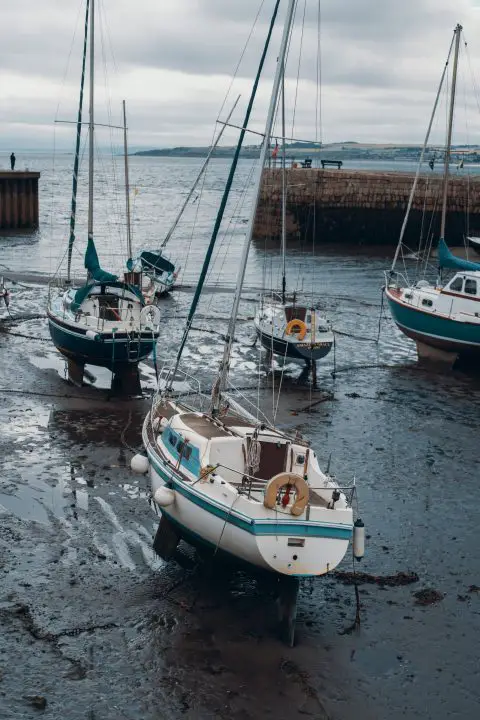
What Is a Boat Rudder?
The rudder is the underwater part of the boat that helps it turn and change direction. It’s mounted on the rear of the boat. When the wheel or tiller in the cockpit is turned, the rudder moves to one side or another. That, in turn, moves the boat’s bow left or right.
When it comes to sailing, rudders also offer a counterbalance to the underwater resistance caused by the keel. This enables the boat to sail in a straight line instead of just spinning around the keel.
Sailboat hull designs vary widely when you view them out of the water. But while the actual shape and sizes change, they all have two underwater features that enable them to sail–a rudder and a keel.
The rudder is mounted at the back of the boat and controls the boat’s heading or direction as indicated by the compass .
The keel is mounted around the center of the boat. Its job is to provide a counterbalance to the sails. In other words, as the wind presses on the sails, the weight of the ballast in the keel and the water pressure on the sides of the keel keeps the boat upright and stable.
When sailing, the keel makes a dynamic force as water moves over it. This force counters the leeway made by air pressure on the sails and enables the boat to sail windward instead of only blowing downwind like a leaf on the surface.
The rudder is a fundamental feature of all boats. Early sailing vessels used a simple steering oar to get the job done. Over the years, this morphed into the rudder we know today.
However, thinking about a rudder in terms of a steering oar is still useful in understanding its operation. All it is is an underwater panel that the helmsperson can control. You can maintain a course by trailing the oar behind the boat while sailing. You can also change the boat’s heading by moving it to one side or the other.
The rudders on modern sailboats are a little slicker than simple oars, of course. They are permanently mounted and designed for maximum effectiveness and efficiency.
But their operating principle is much the same. Rudders work by controlling the way water that flows over them. When they move to one side, the water’s flow rate increases on the side opposite the turn. This faster water makes less pressure and results in a lifting force. That pulls the stern in the direction opposite the turn, moving the bow into the turn.
Nearly all boats have a rudder that works exactly the same. From 1,000-foot-long oil tankers to tiny 8-foot sailing dinghies, a rudder is a rudder. The only boats that don’t need one are powered by oars or have an engine whose thrust serves the same purpose, as is the case with an outboard motor.
Operating the Rudder on a Sailboat
Rudders are operated in one of two ways–with a wheel or a tiller. The position where the rudder is operated is called the helm of a boat .
Ever wonder, “ What is the steering wheel called on a boat ?” Boat wheels come in all shapes and sizes, but they work a lot like the wheel in an automobile. Turn it one way, and the boat turns that way by turning the rudder.
A mechanically simpler method is the tiller. You’ll find tiller steering on small sailboats and dinghies. Some small outboard powerboats also have tiller steering. Instead of a wheel, the tiller is a long pole extending forward from the rudder shaft’s top. The helmsperson moves the tiller to the port or starboard, and the bow moves in the opposite direction. It sounds much more complicated on paper than it is in reality.
Even large sailboats will often be equipped with an emergency tiller. It can be attached quickly to the rudder shaft if any of the fancy linkages that make the wheel work should fail.
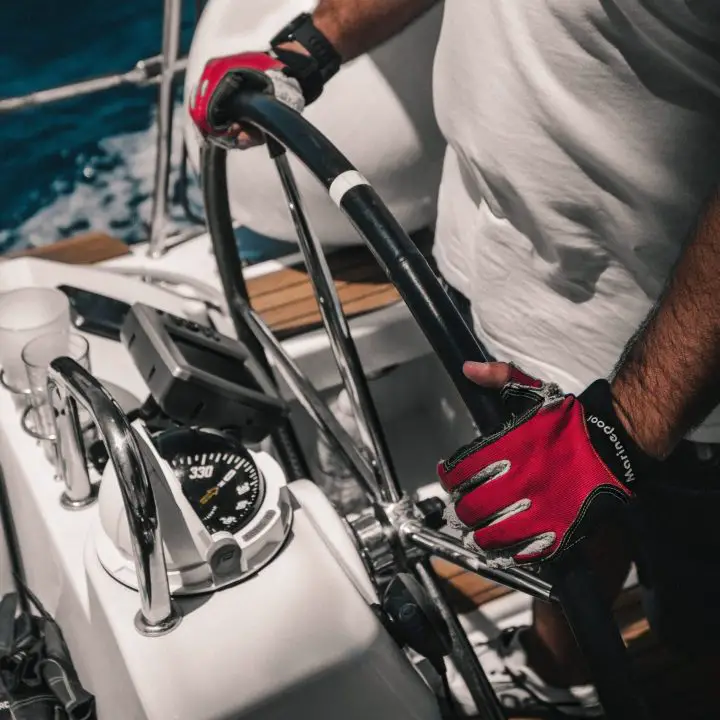
Various Sail Boat Rudder Designs
Now, let’s look at the various types of rudders you might see if you took a virtual walk around a boatyard. Since rudders are mostly underwater on the boat’s hull, it’s impossible to compare designs when boats are in the water.
Keep in mind that these rudders work the same way and achieve the same results. Designs may have their pluses and minuses, but from the point of view of the helmsperson, the differences are negligible. The overall controllability and stability of the boat are designed from many factors, and the type of rudder it has is only one of those.
You’ll notice that rudder design is closely tied to keel design. These two underwater features work together to give the boat the sailing characteristics the designer intended.
The classic, robust offshore sailboat is designed with a full keel that runs from stem to stern. With this sort of underwater profile, it only makes sense that the rudder would be attached to the trailing edge of that enormous keel. On inboard-powered sailboats, the propeller is usually mounted inside an opening called the aperture between the keel and rudder.
The advantages of this design are simplicity and robustness. The keel is integrated into the hull and protects the rudder’s entire length. Beyond reversing into an obstacle, anything the boat might strike would hit the keel first and would be highly unlikely to damage the rudder. Not only does the keel protect it, but it also provides a very strong connection point for it to be attached to.
Full keel boats are known for being slow, although there are modern derivatives of these designs that have no slow pokes. Their rudders are often large and effective. They may not be the most efficient design, but they are safe and full keels ride more comfortably offshore than fin-keeled boats.
Plenty of stout offshore designs sport full keel rudders. The Westsail 38s, Lord Nelsons, Cape Georges, Bristol/Falmouth Cutters, or Tayana 37s feature a full keel design.
A modified full keel, like one with a cutaway forefoot, also has a full keel-style rudder. These are more common on newer designs, like the Albergs, Bristols, Cape Dorys, Cabo Ricos, Island Packets, or the older Hallberg-Rassys.

A design progression was made from full keel boats to long-fin keelboats, and the rudder design changed with it. Designers used a skeg as the rudder became more isolated from the keel. The skeg is a fixed structure from which you can mount the rudder. This enables the rudder to look and function like a full keel rudder but is separated from the keel for better performance.
The skeg-hung rudder has a few of the same benefits as a full keel rudder. It is protected well and designed robustly. But, the cutaways in the keel provide a reduced wetted surface area and less drag underwater, resulting in improved sailing performance overall.
Larger boats featuring skeg-mounted rudders include the Valiant 40, Pacific Seacraft 34, 37, and 40, newer Hallberg-Rassys, Amels, or the Passport 40.
It’s worth noting that not all skegs protect the entire rudder. A partial skeg extends approximately half the rudder’s length, allowing designers to make a balanced rudder.
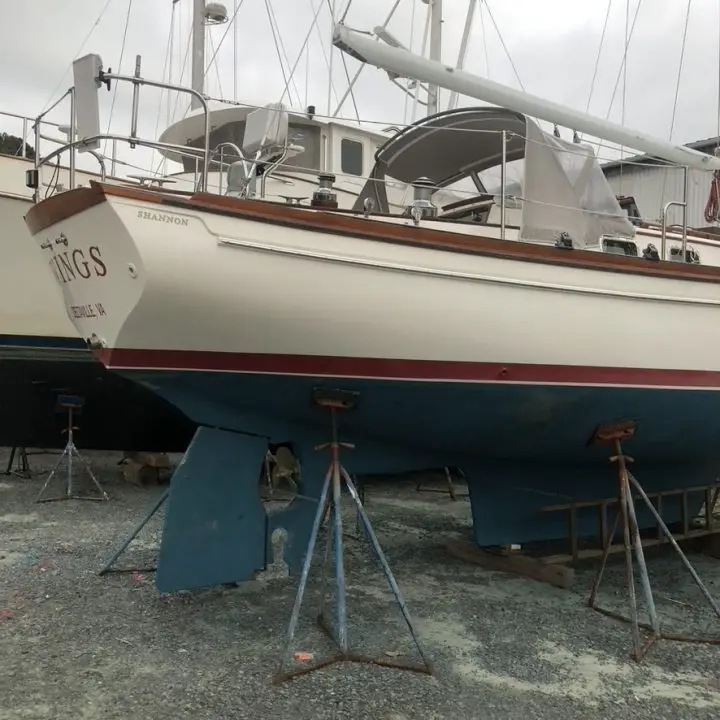
With higher-performance designs, keels have become smaller and thinner. Fin keel boats use more hydrodynamic forces instead of underwater area to counter the sail’s pressure. With the increased performance, skegs have gone the way of the dinosaurs. Nowadays, rudders are sleek, high aspect ratio spade designs that make very little drag. They can be combined with a number of different keel types, including fin, wing keels , swing keels, or bulb keels.
The common argument made against spade rudders is that they are connected to the boat by only the rudder shaft. As a result, an underwater collision can easily bend the shaft or render the rudder unusable. In addition, these rudders put a high load on the steering components, like the bearings, which are also more prone to failure than skeg or full keel designs. For these reasons, long-distance cruisers have traditionally chosen more robust designs for the best bluewater cruising sailboats .
But, on the other hand, spade rudders are very efficient. They turn the boat quickly and easily while contributing little to drag underwater.
Spade rudders are common now on any boat known for performance. All racing boats have a spade rudder, like most production boats used for club racing. Pick any modern fin keel boat from Beneteau, Jeanneau, Catalina, or Hunter, and you will find a spade rudder. Spade rudders are common on all modern cruising catamarans, from the Geminis to the Lagoons, Leopards, and Fountaine Pajots favored by cruisers and charter companies.
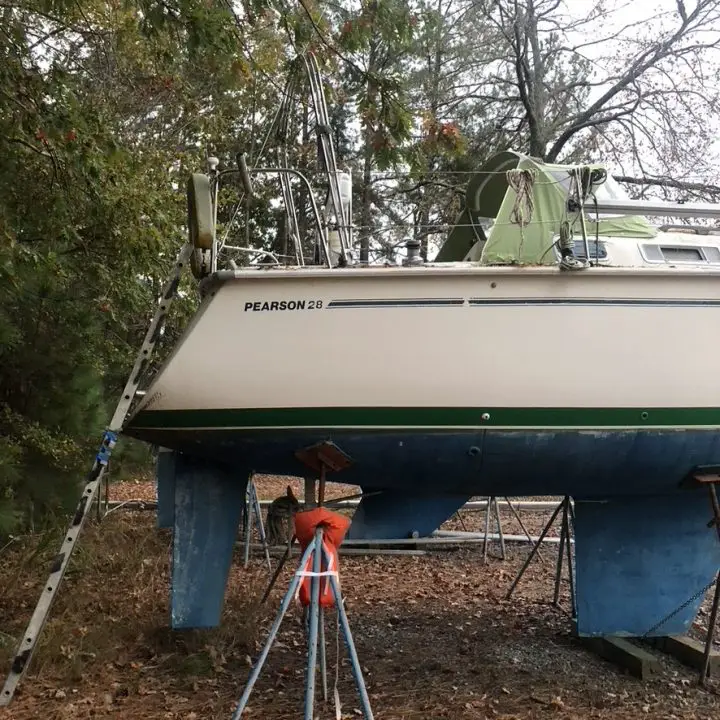
Here are two alternative designs you might see out on the water.
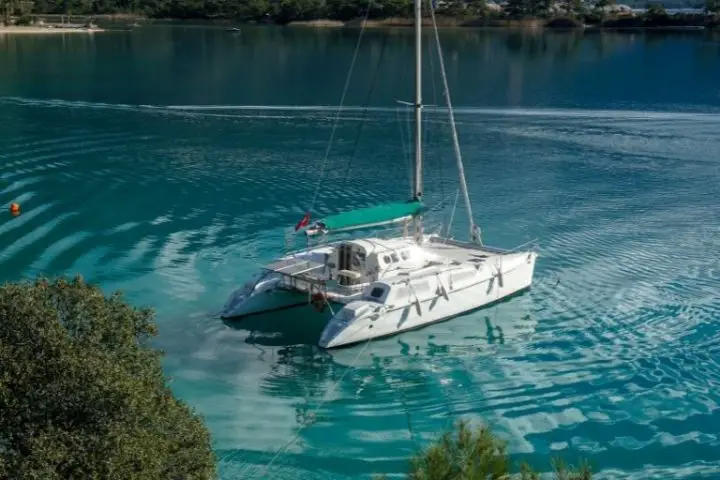
Transom-Hung or Outboard Rudders
An outboard rudder is hung off the boat’s transom and visible while the boat is in the water. Most often, this design is controlled by a tiller. They are common on small sailing dingies, where the rudder and tiller are removable for storage and transport. The rudder is mounted with a set of hardware called the pintle and gudgeon.
Most outboard rudders are found on small daysailers and dinghies. There are a few classic big-boat designs that feature a transom-hung rudder, however. For example, the Westsail 38, Alajuela, Bristol/Falmouth Cutters, Cape George 36, and some smaller Pacific Seacrafts (Dana, Flicka) have outboard rudders.
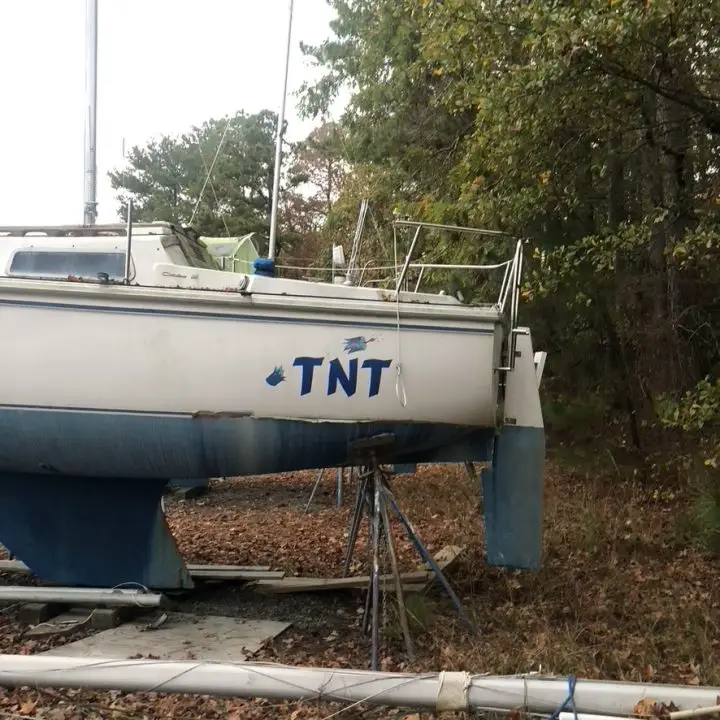
Twin Sailing Rudder Designs
A modern twist that is becoming more common on spade rudder boats is the twin sailboat rudder. Twin rudders feature two separate spade rudders mounted in a vee-shaped arrangement. So instead of having one rudder pointed down, each rudder is mounted at an angle.
Like many things that trickle down to cruising boats, the twin rudder came from high-performance racing boats. By mounting the rudders at an angle, they are more directly aligned in the water’s flow when the boat is healed over for sailing. Plus, two rudders provide some redundancy should one have a problem. The twin rudder design is favored by designers looking to make wide transom boats.
There are other, less obvious benefits of twin rudders as well. These designs are easier to control when maneuvering in reverse. They are also used on boats that can be “dried out” or left standing on their keel at low tide. These boats typically combine the twin rudders with a swing keel, like Southerly or Sirius Yachts do. Finally, twin rudders provide much better control on fast-sailing hulls when surfing downwind.
Unbalanced vs. Balanced Rudders
Rudders can be designed to be unbalanced or balanced. The difference is all in how they feel at the helm. The rudder on a bigger boat can experience a tremendous amount of force. That makes turning the wheel or tiller a big job and puts a lot of strain on the helmsperson and all of the steering components.
A balanced rudder is designed to minimize these effects and make turning easier. To accomplish this, the rudder post is mounted slightly aft of the rudder’s forward edge. As a result, when it turns, a portion of the leading edge of the rudder protrudes on the opposite side of the centerline. Water pressure on that side then helps move the rudder.
Balanced rudders are most common in spade or semi-skeg rudders.
Sail Rudder Failures
Obviously, the rudder is a pretty important part of a sailboat. Without it, the boat cannot counter the forces put into the sails and cannot steer in a straight line. It also cannot control its direction, even under power.
A rudder failure of any kind is a serious emergency at sea. Should the rudder be lost–post and all–there’s a real possibility of sinking. But assuming the leak can be stopped, coming up with a makeshift rudder is the only way you’ll be able to continue to a safe port.
Rudder preventative maintenance is some of the most important maintenance an owner can do. This includes basic things that can be done regularly, like checking for frayed wires or loose bolts in the steering linkage system. It also requires occasionally hauling the boat out of the water to inspect the rudder bearings and fiberglass structure.
Many serious offshore cruisers install systems that can work as an emergency rudder in extreme circumstances. For example, the Hydrovane wind vane system can be used as an emergency rudder. Many other wind vane systems have similar abilities. This is one reason why these systems are so popular with long-distance cruisers.
There are also many ways to jury rig a rudder. Sea stories abound with makeshift rudders from cabinet doors or chopped-up sails. Sail Magazine featured a few great ideas for rigging emergency rudders .
Understanding your sail rudder and its limitations is important in planning for serious cruising. Every experienced sailor will tell you the trick to having a good passage is anticipating problems you might have before you have them. That way, you can be prepared, take preventative measures, and hopefully never deal with those issues on the water.
What is the rudder on a sailboat?
The rudder is an underwater component that both helps the sailboat steer in a straight line when sailing and turn left or right when needed.
What is the difference between a rudder and a keel?
The rudder and the keel are parts of a sailboat mounted underwater on the hull. The rudder is used to turn the boat left or right, while the keel is fixed in place and counters the effects of the wind on the sails.
What is a rudder used for on a boat?
The rudder is the part of the boat that turns it left or right
Matt has been boating around Florida for over 25 years in everything from small powerboats to large cruising catamarans. He currently lives aboard a 38-foot Cabo Rico sailboat with his wife Lucy and adventure dog Chelsea. Together, they cruise between winters in The Bahamas and summers in the Chesapeake Bay.
Leave a comment
Your email address will not be published. Required fields are marked *
Save my name, email, and website in this browser for the next time I comment.
- New Sailboats
- Sailboats 21-30ft
- Sailboats 31-35ft
- Sailboats 36-40ft
- Sailboats Over 40ft
- Sailboats Under 21feet
- used_sailboats
- Apps and Computer Programs
- Communications
- Fishfinders
- Handheld Electronics
- Plotters MFDS Rradar
- Wind, Speed & Depth Instruments
- Anchoring Mooring
- Running Rigging
- Sails Canvas
- Standing Rigging
- Diesel Engines
- Off Grid Energy
- Cleaning Waxing
- DIY Projects
- Repair, Tools & Materials
- Spare Parts
- Tools & Gadgets
- Cabin Comfort
- Ventilation
- Footwear Apparel
- Foul Weather Gear
- Mailport & PS Advisor
- Inside Practical Sailor Blog
- Activate My Web Access
- Reset Password
- Pay My Bill
- Customer Service

- Free Newsletter
- Give a Gift

How to Sell Your Boat

Cal 2-46: A Venerable Lapworth Design Brought Up to Date

Rhumb Lines: Show Highlights from Annapolis

Open Transom Pros and Cons

Leaping Into Lithium

The Importance of Sea State in Weather Planning

Do-it-yourself Electrical System Survey and Inspection

Install a Standalone Sounder Without Drilling

Rethinking MOB Prevention

Top-notch Wind Indicators

The Everlasting Multihull Trampoline

In Search of the Snag-free Clew

What’s Involved in Setting Up a Lithium Battery System?

Reducing Engine Room Noise

Breaking Point: What Can Go Wrong With Your Yanmar?

Mildew-resistant Caulks for Boats

Can We Trust Plastic Boat Parts?

Repairing Molded Plastics

Mailport: Marine plywood, fuel additives, through bolt options, winch handle holders

The Day Sailor’s First-Aid Kit

Choosing and Securing Seat Cushions

Cockpit Drains on Race Boats

Rhumb Lines: Livin’ the Wharf Rat Life

Resurrecting Slippery Boat Shoes

Shoe Goo’s Gift to Sailors

Tricks and Tips to Forming Do-it-yourself Rigging Terminals

Marine Toilet Maintenance Tips

Learning to Live with Plastic Boat Bits

The Ultimate Guide to Caring for Clear Plastic
- Boat Maintenance
Building a Faster Rudder
Boost performance with a bit of fairing and better balanced helm..
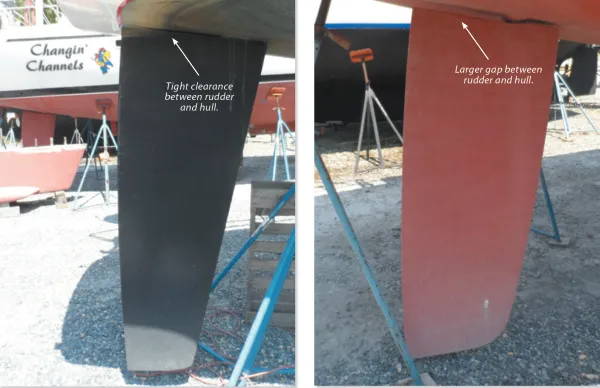
We’re cruisers not racers. We like sailing efficiently, but we’re more concerned with safety and good handling than squeezing out the last fraction of a knot. Heck, we’ve got a dinghy on davits, placemats under our dishes, and a print library on the shelf. So why worry about perfection below the waterline?
The reason is handling. A boat with poorly trimmed sails and a crudely finished rudder will miss tacks and roll like a drunkard downwind when the waves are up. On the other hand, a rudder that is properly tuned will agilely swing the boat through tacks even in rough weather, and provide secure steering that helps prevents broaching when things get rolly. The difference in maximum available turning force between a smooth, properly fitted rudder and the same rudder with a rough finish and poor fit can be as much as 50% in some circumstances, and those are circumstances when you need it the most. It’s not about speed, it’s about control.
It Must Be Smooth
Smooth is fast. That’s obvious. But it makes an even bigger difference with steering. Like sails, only half of rudder force comes from water deflected by the front side of the blade. The rest results from water being pulled around the backside as attached flow. How well that flow stays attached is related to the shape of the blade, which we can’t easily change, and to the surface finish of the blade, which we can.
Remember the school experiment, where you place a spoon in a stream of water and watched how the water would cling to the backside of the spoon? Now, try the experiment again as a grown-up, but with a different set of materials.
Try this with a piece of wood that is smooth and one that is very rough; the water will cling to the smooth surface at a greater angle than the rough surface. Try piece of smooth fiberglass or gelcoat; the water will cling even better because the surface is smoother. Try a silicone rubber spatula from the kitchen. Strangely, even though the surface is quite smooth, the water doesn’t cling well at all. We’ll come back to that.
Investigators have explored this in a practical way, dragging rudders through the water in long test tanks (US Navy) and behind powerboats.
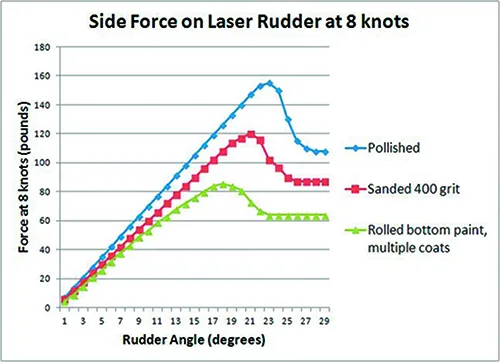
If we are trying to climb to windward, it’s nice to get as much lift out of the rudder as practical, before drag becomes too great or before it begins to stall with normal steering adjustments. If the boat has an efficient keel and the leeway angle is only a few degrees, the rudder can beneficially operate at a 4-6 degree angle. The total angle of attack for the rudder will be less than 10 degrees, drag will be low, and pointing will benefit from the added lift. If the boat is a higher leeway design—shoal draft keels and cruising catamarans come to mind—then the rudder angle must stay relatively low to avoid the total angle (leeway + rudder angle) of the rudder from exceeding 10 degrees. That said, boats with truly inefficient keels but large rudders (catamarans have two—they both count if it is not a hull-flying design) can sometimes benefit from total angles slightly greater than 10 degrees—they need lift anywhere they can get it.
How can you monitor the rudder angle? If the boat is tiller steered, the tiller will be about 0.6 inches off center for every degree or rudder angle, for every 3 feet of tiller length. In other words, the 36-inch tiller should not be more than about 2 inches off the center line. If the boat is wheel steered, next time the boat is out of the water, measure the rudder angle with the wheel hard over. Count the number of turns of the wheel it takes to move the rudder from centered to rudder hard over, and measure the wheel diameter. Mark the top of the rim of the wheel when the boat is traveling straight, preferably coasting without current and no sails or engine to create leeway.
The rim of the wheel will move (diameter x 3.146 x number of turns)/(degrees rudder angle at hard over) for each degree of rudder angle. Keep this in the range of 2-6 degrees when hard on the wind, as appropriate to your boat. It will typically be on the order of 4-10 inches at the steering wheel rim. A ring of tape at 6 degrees can help.
How do we minimize rudder angle while maintaining a straight course? Trimming the jib in little tighter or letting the mainsheet or traveler out a little will reduce pressure on the rudder and reduce the angle. Some boats actually sail to weather faster and higher, and with better rudder angles, by lowering the traveler a few inches below the center line.
On the other hand, tightening the mainsheet and bringing the traveler up, even slightly above the center line on some boats, will increase the pressure and lift.
Much depends on the course, the sails set, the rig, the position of the keel, the wind, and the sea state. Ultimately, some combination of small adjustments should bring the rudder angle into the appropriate range. Too much rudder angle and you are just fighting yourself.
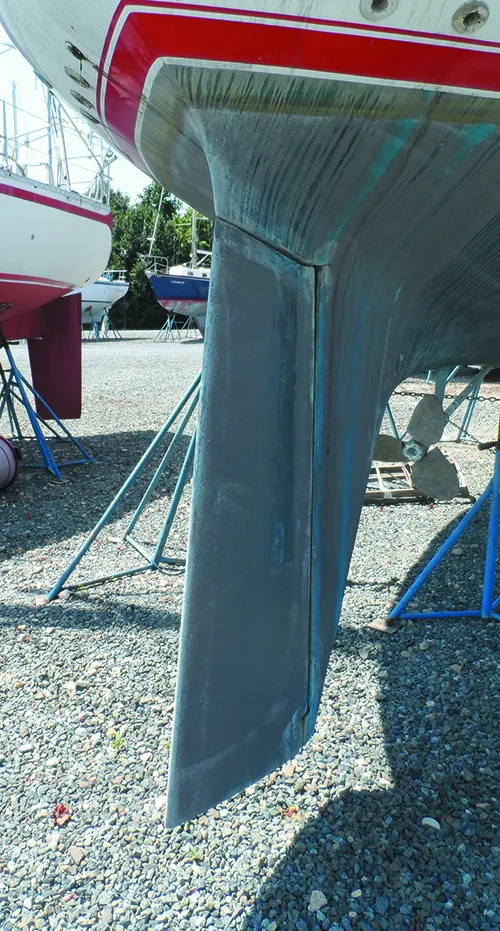
- Turn this rudder just 10 degrees and the end plate is lost, reducing the amount of lift generated.
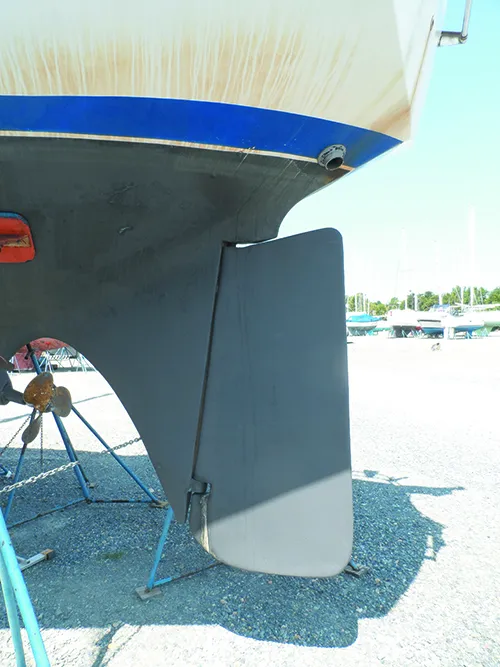
- This rudder might as well be transom hung, the way that the end cap just disappears.
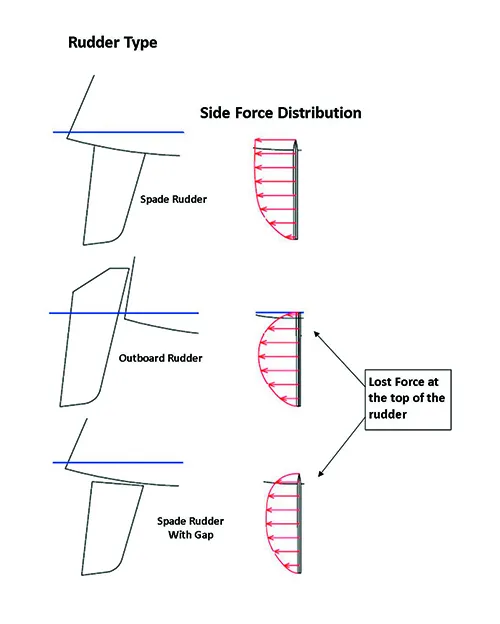
- Stern-hung rudders, and spade rudders with large gaps between the hull and the top of the rudder will lose their lift at the “tip” of the blade near the surface.
Surface roughness affects the lift from the rudder in two ways. A rougher surface has slightly lower lift through the entire range of angles, the result of a turbulent boundary layer instead of smooth flow over the entire surface. More dramatically, rougher blades stall at lower angles and stall more completely. The difference between a faired rudder with a polished finish and a rudder carrying a 10-year accumulation of rolled-on antifouling paint can be as much is 35 percent (see “Rudder Savvy to Boost Boat Performance,” above).
What can we do? If your rudder is a lift up type, don’t use bottom paint. Fair the blade within an inch of its life and lay on a gloss topside paint as smoothly as possible, sanding between coats. If you use a brush, stroke the brush parallel to the waterline, not along the length of the blade.
Which is faster, a gloss finish or one that has been dulled with 1000 grit sandpaper? Opinions go both ways, and we believe it may depend on the exact nature of the paint, which leads to the question, “Should we wax the blade?” The answer is a resounding, no.
Wax is a hydrophobic (readily beads water), like the silicone rubber spatula you tested, and as a result, water doesn’t always cling as well. Thus, whether the paint should be deglossed or not depends on the chemistry of the paint, but in all cases the final sanding should be 1000 grit or finer.
If the rudder stays in the water, antifouling paint is required. Sand the prior coat perfectly smooth. There should be no evidence of chips, runners, or any irregularity at all. Using a mohair roller, lay the paint on thin, and apply multiple coats to withstand the scrubbing you will give your rudder from time to time.
Even if you use soft paint on the rest of the boat, consider hard paint for the rudder. Sure, it will build up and you will have to sand it off periodically, but the rudder is small and no part of your boat is more critical to good handling. Take the time to maintain it as a perfect airfoil.
Close the Gap
Ever notice the little winglets on the tips of certain airplanes? As we know, those are intended to reduce losses off the tip of the wing. The alternatives are slightly longer wings or slightly lower efficiency. At the fuselage end of the wing, of course, there is no such loss because the fuselage serves as an end plate. The same is true with your rudder.
There’s not much you can do about losses from the tip; making the rudder longer will increase the chance of grounding and increase stress on the rudder, rudder shaft, and bearings. Designers have experimented with winglets, but they the catch weeds and the up-and-down motion of the transom makes them inefficient. However, we can improve the end plate effect of the hull by minimizing the gap between the hull and the rudder.
In principle it should be a close fit, but in practice the gap is most often wide enough to catch a rope. Just how much efficiency is lost by gap of a few inches? The answer is quite a lot. A gap of just an inch can reduce lift by as much as 10-20 percent, depending on the size and shape of the rudder and the speed. A gap of 1-2 mm is quite efficient, but normal flexing of the rudder shaft may lead to rubbing.
If the gap is tight, the slightest bend from impact with a submerged log can cause jamming and loss of steering, though in my experience once the impact is sufficient to bend the shaft, a small difference in clearance is unlikely to make much difference; the shaft will bend until the rudder strikes the hull. Just how tight is practical depends on the type of construction, fitting accuracy, and how conservative the designer was in their engineering.
Carbon shafts, tubular shafts, and rudders with skegs flex less, while solid shafts generally flex more, all things being equal. Normally a clearance of about 1/4-inch per foot of rudder cord is practical, and performance-oriented boats often aim for much less. If you can reach your fingers through, that’s way too much. Hopefully the hull is relatively flat above the rudder so that the gap does not increase too much with rudder angle.
Practical Sailor’s technical editor Drew Frye is the author of the books Keeping a Cruising Book for Peanuts and Rigging Modern Anchors. He blogs at his website, sail delmarva.blogspot.com .
RELATED ARTICLES MORE FROM AUTHOR
21 comments.
How happy to see good technical information about the science of boat speed and control. This information is valuable to everyone, but the “mainly just cruising” cohort usually doesn’t get enough in an easily understandable form. I always suggest some club level racing as the best way to learning how to sail, but many prospective racers have been put off from the sport or haven’t had good opportunities to join the fleets. Technical seminars are generally either too advanced for beginners to understand properly, and the beginner classes are frequently too basic to inspre those who would benefit from a deeper knowledge base in the science of sailing. Good on you, Practical Sailor, for your technical stories hitting the “sweet spot,” getting this information to those we’ll benefit most.
Great article. How about considering modifying a rudder to make it a hydrodynamically balanced rudder. I did it to my boat and the difference is outstanding. If I remember correctly 7% of the rudder area is forward of pivot center. It is a skeg hung rudder that now turns like it’s a spade rudder.
I’m “skeg hung” also. Would you be so kind as to posting a link or providing info as to you accomplished this feat. Thanks!
A very clear explanation of some quite complicated hydrodynamics – thank you! I am surprised by the US Navy results showing benefit of sanding further than 400 grit. Most other experimental data suggest there is negligible advantage in going beyond about 360 grit. Is the original reference publicly available? On Michael Cotton’s comment, a couple of points: Firstly, the amount of balance (i.e how far back you put the stock in the blade) has no impact on the hydrodynamic performance of a spade rudder. What it does do is change the feel of the rudder; a well balanced rudder will be easier to use, thereby probably allowing the steerer to sail the boat better. For a skeg rudder, the hydrodynamic impact of changing the balance depends very much on how the skeg/blade combination is configured. Secondly, 7% of rudder area forward of the stock is not enough for most rudders. The position of the centre of pressure is dependent on a lot of factors (aspect ratio, rudder angle etc.), but it is usually at least 15% back from the leading edge on a spade rudder, more often 20%. A balance somewhere between 10% and 15% is likely to give just enough feel without too much weight. However, rudder balance is still a bit of a black art, it really does depend on the rudder geometry.
the statement that one doesn’t want a silicone/silane coated ( super-smooth, hydrophobic: silicone-silane is just the example I am choosing, since it is now in use as a massively-speeding hull-coating, ttbomk ), as it *induces* flow-separation…
looks to me like conflating cavitation with flow-separation.
People have no problem teflon/ptfe-coating aviation-wings, as a means of *preventing* flow-separation.
the super-slick shape of a Cirrus’s composite wing, if made super-smooth/polished & super-slippery, “air-phobic”, as it were, *improves* its performance, not detracts from it….
Flow is always 1. laminar, then 2. turbulent, then 3. flow-separation.
unless the angle-of-attack ( AoA ) is small-enough to prevent separation.
The Gentry Tufts System, for *seeing* when a separation-bubble begins, on a sail, is brilliant ( Arvel Gentry was a fluid dynamicist, & realized that once one has a *series* of tufts, from luff on back, about 1/4 up the luff, one can *see* the beginning of a flow-separation-bubble, & tune the sail to keep it *just*-beginning, because *that* is MAX lift. Wayback Machine has his site archived, btw )
The aircraft designer Jan Roskam wrote of a DC-10 crashing because pebbled-ice as thick as the grit on 40-grit sandpaper had formed on the upper wings…
obviously, engineered to require laminar, there, but having turbulent, cost all those lives.
iirc, it was Arvel Gentry, or “Principles of Yacht Design”, that stated it takes a ridge of about 0.1mm, only, to trip the flow around a mast from laminar to turbulent…
Given how barnacles & such are generally 100x or more as thick as that, when removed from a hull, I think laminar-flow is something that exists only for the 1st day or so after launching!
I now want to see experiment showing polar curves for rudders coated normally, uncoated, & ailicone-silane coated, to see if it is the coating that induces separation-bubbles, or if it is AoA exceeding functional angle, for that surface & foil,, while the boundary-layer is in specifically turbulent flow, as opposed to the ideal laminar, as aviation’s results indicate…
just an amateur student of naval-architecture & aircraft-design ( Daniel P. Raymer’s “Conceptual Aircraft Design” is *brilliant*, btw ), who happens to study this stuff autistically, as that is the only way to make my designs become absolutely-competent, is all…
I got a pearson and the rudder broke. Can I just replace with a outboard rudder mount it off set for room for outboard need info.
You could but it will not work very well. How badly it would perform is difficult to say. It might be just poor or disastrous. Things really need to be balanced on sail boats.
Polished rudders stall at low angles of attack and ask any hobie cat racer.
Pi is NOT 3.146
3.1416 maybe
Yup, 3.1416. Typo.
Before 2005 , when I fully retired and went cruising 10 months per year, I changed auto pilots, the hydraulics of which reduced the maximum rudder angle. “Someday” had always been difficult to steer in marinas, so I added 30% more rudder area to the Gulfstar 41′ by deepening and following the existing angles. (the pivot was unchanged, as all added area was aft of that.) It increased rudder effort noticeably, but not excessively, improved motor maneauvering and allowed being able to hold a close line better. Noticeably, it caused a lot more stalling of the rudder whenever it was turned very much. A recent tangle with a Guatemala fish net damaged the extension, which I had intended to be sacrificial. I cleaned up the separation somewhat, but have not replaced the extension. The boat again now requires more steering correction when heading at all upwind, but the rudder does not stall as easily.
This is not a scientific study, just my personal non-scientific observations. The added rudder area was quite low, and the fairing quality was…well! modest.
I’ve seen data suggesting ~ 400 grit is best, and I’ve seen data suggesting polished is best. They were both smart, respected guys that I would not second guess. My conclusion is that other factors, such as the specific foil profile and the type of coating, are involved. Let’s just agree that many layers of rolled bottom paint with a few lumps and chips is sub-optimal! We’re talking about cruising boats.
Thanks for great article. I’m convinced enough to go sand my bottom paint off the lifting rudder of my Dragonfly Tri.
Absolutely! No lifting rudder should have bottom paint. My Farrier rudder was sanded fair and painted with gloss white.
Dagger boards and center boards that retract still need antifouling, since they do not lift clear of the water, but because they are in a confined space with little oxygen or water flow, fouling is very limited. Because the space is tight and paint build-up can cause jamming, sand well and limit the number of coats. For my center board I go with two coats on the leading edge (exposed even when lifted) and one coat on the rest.
I do remember a comment directed to cruisers a few years back suggesting that a faster cruiser would be more likely to get out of the way of dirty weather, especially with modern forecasting. I reckoned that this concept would gain traction, but I haven’t seen it. Can anyone weigh in on this opinion?
As interesting as the article reads, I wonder how it helps a prospective buyer of a used boat. Pictures will not do, and neither will taking several boats out of the water to examine them; it’s too expensive. It would be more helpful to indicate which boat manufacturers have the type of rudder the author recommends. After all, the buyer usually cannot be expected to change a rudder prior to buying it; it is also expensive. By the way, these types of very sophisticated articles are seen when it comes to hulls, keels, or rigging but without identifying the boats that carry the wrong equipment. If a specific rudder or keel configuration is not the proper one for efficient sailing, the author ought to state which boats carry the proper ones so that the buyer will concentrate on the whole (the boat) rather than the part.
I was describing the opportunity to improve the existing rudder. As I think back, I have modified the rudder of every boat I have owned in order to improve efficiency. The first two got small changes in balance and improved trailing edge sharpness. On the third I tightened the the hull clearance and changed the section. On my current boat I adding an anti-ventilation fence to improve high speed handling. https://4.bp.blogspot.com/-2ZGPzKdj_tE/WyF9G2mHtLI/AAAAAAAAOwE/r6zgQEr4vkcDB4ciMLcgboFdazDAseDBgCLcBGAs/s1600/ian%2Brudder%2Bfence.jpg None of these tasks was overly difficult, and none was undertaken until I had sailed the boat for a season and learned what balance she liked and noted her habits.
For me, I buy a boat based on reputation, a test sail, and in most cases, a survey. As you imply, it is the whole boat you are buying. Does it have good bones? Do you feel happy at the helm? Then comes the fine tuning. I’ve been told that I sell a boat when I run out of things to tweak.
wow, so now case reports/medical reports/evidence don’t count as “evidence”, but certain remedies, even if they are cited in medical journals but do not work in the real world, count as evidence to you?? Maybe we need to redefine evidence based on your philosophies.Anyway, i’ve wasted enough time here. goodbye.
Weight 2.5 tonnes
Do you have any articles on the ideal cross section shape for an outboard rudder mounted 50mm from the transom vertically The yacht is a 26 ft trailer sailer weight 2.5 tonnes
The most common choice would be NACA 0012. http://airfoiltools.com/airfoil/details?airfoil=n0012-il
There are many ways to build a rudder, including laminated solid rot-resistant wood and fiber glass covered foam with a metal armature core. For the DIY, laminated wood is probably the most practical.
LEAVE A REPLY Cancel reply
Log in to leave a comment
Latest Videos
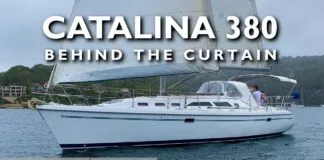
Catalina 380: What You Should Know | Boat Review
- Privacy Policy
- Do Not Sell My Personal Information
- Online Account Activation
- Privacy Manager
- Types of Sailboats
- Parts of a Sailboat
- Cruising Boats
- Small Sailboats
- Design Basics
- Sailboats under 30'
- Sailboats 30'-35
- Sailboats 35'-40'
- Sailboats 40'-45'
- Sailboats 45'-50'
- Sailboats 50'-55'
- Sailboats over 55'
- Masts & Spars
- Knots, Bends & Hitches
- The 12v Energy Equation
- Electronics & Instrumentation
- Build Your Own Boat
- Buying a Used Boat
- Choosing Accessories
- Living on a Boat
- Cruising Offshore
- Sailing in the Caribbean
- Anchoring Skills
- Sailing Authors & Their Writings
- Mary's Journal
- Nautical Terms
- Cruising Sailboats for Sale
- List your Boat for Sale Here!
- Used Sailing Equipment for Sale
- Sell Your Unwanted Gear
- Sailing eBooks: Download them here!
- Your Sailboats
- Your Sailing Stories
- Your Fishing Stories
- Advertising
- What's New?
- Chartering a Sailboat
- Sailboat Rudders
Sailboat Rudders
The primary purpose of sailboat rudders is of course to give the helmsman the ability to steer the boat, but a well-designed one will also provide hydrodynamic lift to windward, in the same manner as does the keel.
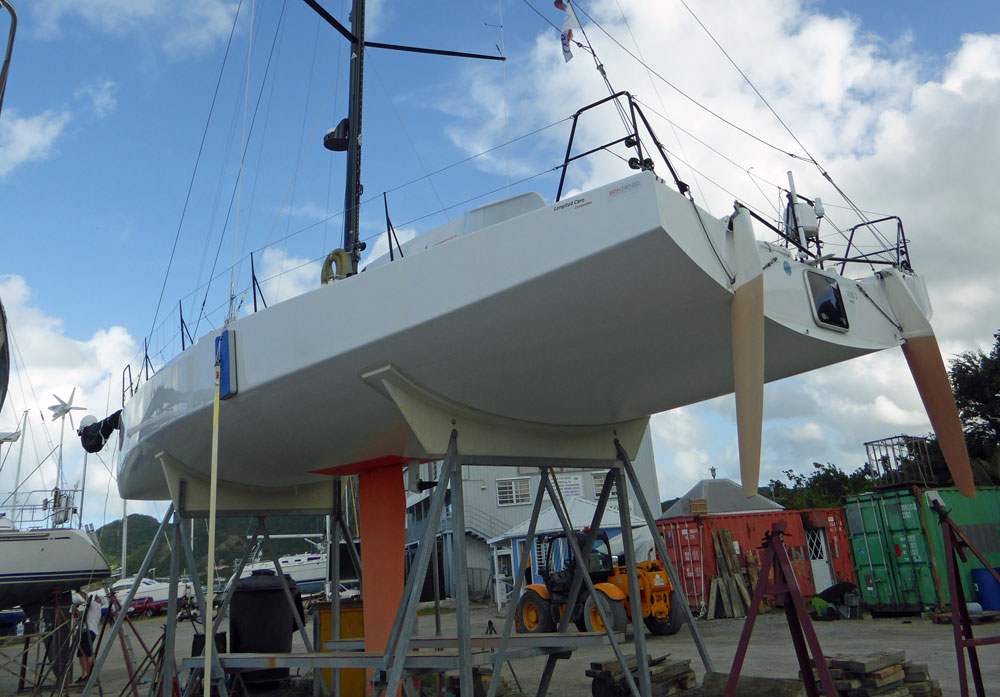
Placing sailboat rudders into distinct categories is fairly straight forward - they're either:
- Outboard or inboard rudders, which can be
- Unbalanced, balanced or semi-balanced, and be
- Keel-hung, skeg-hung, transom-hung or spade rudders.
Take a stroll around any fair-sized boatyard during the lay-up season and you'll see examples of most of them...
Inboard & Outboard Sailboat Rudders
If the rudderstock passes through the underside of a boat's hull, it's an inboard rudder. Conversely, if it doesn't, it's an outboard rudder.
Most outboard rudders are turned by a tiller as there's no rudderstock to which a wheel-steering quadrant can be mounted.
The two rudders shown below are quite different examples of outboard rudders.
Fig 1 shows an example of a keel-hung outboard rudder that is seldom seen on today's cruising boats.
Outboard rudders like the one in Fig 2 can be easily removed for service or repair with the vessel afloat. You might struggle with trying to do that with the 'barn door' of a rudder in Fig 1 though!
Examples of inboard rudders can be seen in Figs 3, 4, 5, 6, 7 & 9.
Unbalanced Rudders
This unbalanced rudder is supported by a full-length skeg.
It is unbalanced because the entirety of the rudder is aft of its axis, the axis being on the centreline of the rudderstock.
When turned, the full force of the water flowing past the skeg acts on one side of the rudder - a fact that will be very much apparent to the helmsman, particularly on a tiller-steered boat.
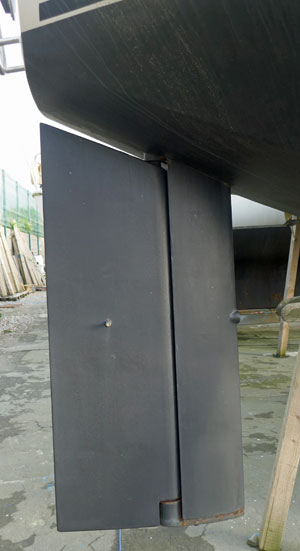
Recent Articles
Used Sailing Equipment For Sale
Feb 28, 24 05:58 AM
My Vagabond 47 Sailboat 'Untethered Soul' is for Sale
Feb 27, 24 12:40 PM
The Newport 41 Sailboat
Feb 24, 24 04:33 AM
Here's where to:
- Find Used Sailboats for Sale...
- Find Used Sailing Gear for Sale...
- List your Sailboat for Sale...
- List your Used Sailing Gear...
- Sign-up for our newsletter, 'The Sailboat Cruiser' ...
- Identify this month's Mystery Boat...
Our eBooks...

A few of our Most Popular Pages...

Copyright © 2024 Dick McClary Sailboat-Cruising.com
Yachting Monthly
- Digital edition

How keel type affects performance
- Chris Beeson
- December 2, 2016
James Jermain looks at the main keel types, their typical performance and the pros and cons of each

A fin keel and spade rudder configuration gives high pointing but can be sensitive on the helm Credit: Graham Snook/YM

James Jermain has tested hundreds of yachts in his 30 years as Yachting Monthly’s chief boat tester
The performance and handling of a yacht depends on many things, but perhaps the most important single feature is the shape of the hull and the profile of the keel. Over the years hulls have become shallower and keels narrower, but for many types of sailing this progression is not necessarily progress. Of the various shapes that have evolved, each has its own advantages in different circumstances. Here is a run-down of how they may fit your sort of sailing.
FIN KEEL WITH SPADE RUDDER

A low wetted surface area and aerofoil shape means speed and agility
The most common modern option, usually combined with light but beamy hulls with high freeboard.
GENERAL AND TO WINDWARD
- Low wetted surface and good aerofoil shape means good speed, high pointing and quick tacking
- Light steering
- Best designs can slice through heavy seas in reasonable comfort
- High volume, light-weight designs can be lively and tiring in heavy weather
- Flat sections can cause slamming
- Less steady on the helm, requiring more work and concentration
- Strong tendency to round-up when hard pressed
- Generally require earlier reefing
- Can be unstable when hove to
- Quick to surf and may even plane
- Can broach easily and suddenly
- Can be directionally unstable and hard to control in heavy conditions
UNDER POWER
- Handling is precise and turns tight and quick
- Some handle almost as well astern as ahead
- Limited lateral area so susceptible to beam winds at low speeds
- An unattended helm can slam over suddenly
FIN KEEL WITH SKEG RUDDER

The skeg running aft protects the rudder and improves tracking under sail and power
Similar to above but with some key differences.
- Skeg provides better support for the rudder
- Tracking under sail or power is improved
- There is less chance of damage
- More wetted surface so potentially slower
- Objects can get stuck between rudder and skeg
- Limited balancing can make helm heavier

The mass of a long keel is often more seakindly and will carry way well.
The traditional option, usually found on pre-1970s designs.
- Good tracking
- Slow, soft, comfortable motion
- Drive powerfully through short seas but can be wet
- Carry way through tacks
- Resist rounding-up
- Heave-to well
- High wetted surface area and a poor aerofoil shape, so speed reduced, tacking slow, leeway increased and pointing ability reduced
- Long ends can cause hobby-horsing
- An unbalanced hull or rig can cause heavy helm
- Track well and very resistant to broaching
- Very stable in heavy conditions
- Reluctant to surf (a mixed blessing)
- Carry way well
- Track straight
- Heavy construction can reduce vibration and noise
- Large turning circle ahead
- Unpredictable and hard to control astern
LIFTING OR SWING KEEL

A lifting keel enables beaching, but beware of stones jamming the plate
The ultimate shallow-draught option.
- A fully retracting keel offers shallowest draught
- A well-designed lifting keel can be very efficient and fast
- Grounding on anything other than soft mud or sand can damage an unprotected hull
- Stub keels offer better protection but are less efficient and prevent level drying out, except in soft mud
- Stones and dried mud can jam the lifting plate
- Internal keel boxes reduce accommodation space
- Directional stability is poor
- Early surfing and planing
- Control can easily be lost in strong winds
- Good performance and handling with keel down
- Directional control increasingly poor as the keel is raised
TWIN OR BILGE KEEL

A bilge-keeler will dry out upright on a flat bottom
A popular shoal-draught option in Britain, less so abroad.
- Shallower draught
- Dry out upright on a flat bottom
- Good protection when grounding
- Good designs are better to windward than long keels, almost as good as fins
- Pointing and speed to windward is reduced, considerably so in older designs
- When well heeled, waves can slap under the windward keel
- Can topple over if one keel finds a hole or soft ground

Modified water flow over the wing keel foot can give the motion of a longer, heavier boat
Once popular, now largely replaced with various types of bulb.
- Reduced draught
- Low CoG means good righting moment
- Modified water flow over keel foot means greater efficiency and gives the motion of a longer, heavier boat
- More likely to pick up lobster pots, etc
- Risky drying out
- Weed and barnacle growth under wings difficult to remove
Enjoyed reading this?
A subscription to Yachting Monthly magazine costs around 40% less than the cover price .
Print and digital editions are available through Magazines Direct – where you can also find the latest deals .
YM is packed with information to help you get the most from your time on the water.
- Take your seamanship to the next level with tips, advice and skills from our experts
- Impartial in-depth reviews of the latest yachts and equipment
- Cruising guides to help you reach those dream destinations
Follow us on Facebook , Twitter and Instagram.
The Types of Sailboat Rudders
- Snowboarding
- Scuba Diving & Snorkeling
Full Keel Rudder
On a sailboat , as the rudder is moved to one side by means of the tiller or steering wheel, the force of the water striking one edge of the rudder turns the stern in the other direction to turn the boat. Different types of rudders have different advantages and disadvantages. The type of rudder is often related to the boat’s type of keel.
Rudder on Full-Keel Sailboat
As shown in this photo, the rudder of a full-keel boat is usually hinged to the aft edge of the keel, making a continuous surface. The engine’s propeller is usually positioned in an aperture between the keel and rudder.
Advantages of Full Keel Rudder
The primary benefit of this rudder configuration is the strength and protection provided to the rudder. It is hinged at top and bottom, well distributing the forces on the rudder. Rope (such as lobster pot warps) or debris in the water cannot snag on the rudder.
Disadvantage of Full Keel Rudder
Because the sideways force of the water on the rudder is entirely behind the rudder’s pivoting point at its leading edge, putting all the force on one side of the rudder, it takes more energy to move the rudder. This is one reason why larger boats seldom have tillers—because it can require much force to “push” the rudder out against the water streaming past the keel.
Spade Rudder
Most fin keel boats have a spade rudder, which extends straight down from the aft hull section. The rudder post comes down through the hull into the rudder itself, allowing the entire rudder to rotate to either side, pivoting around the post.
Advantages of Spade Rudder
The spade rudder is self-standing and does not require a full keel or skeg for its mounting. The rudder post inside the rudder can be moved aft from the leading edge (see next page on Balanced Rudder) so that the force of the water is not all on one side when the rudder is turned. This requires less energy to steer than with a keel- or skeg-mounted rudder.
Disadvantage of Spade Rudder
A spade rudder is more vulnerable to debris or objects in the water, which may strike the rudder and exert a force on the rudder post, the only structure supporting the whole rudder. Even the force of water when the boat “falls” off a wave can exert damaging stress on a spade rudder. If the rudder post is bent, the rudder may jam and become useless.
Balanced Spade Rudder
Note the clear air space at the top of the leading edge of this balanced spade rudder. The rudder post is several inches back from the front of the rudder. When the rudder is turned, the leading edge rotates to one side of the boat while the trailing edge rotates to the other side. While the turning action on the boat is the same, the forces on the helm are more nearly balanced, making it very easy to steer.
Skeg-Mounted Rudder
Some fin keel sailboats have a skeg-mounted rudder like the one shown. The skeg offers the same advantages as a keel mounted rudder: the rudder is protected from objects in the water and has more structural strength than a rudder mounted only on the rudder post.
It also has the same disadvantage: because it is not “balanced” as a spade rudder may be, with water forces distributed on both sides, it requires more force to turn the rudder.
Outboard Rudder
An outboard rudder is mounted outside the hull on the boat’s stern, such as shown in this photo, rather than below the hull using a rudder post or hinges to the keel or skeg. Most outboard rudders are turned with a tiller rather than a steering wheel since there is no rudder post to which to gear a wheel.
Advantages of Outboard Rudder
An outboard rudder does not require a hole through the hull for a rudder post and thus is less likely to cause trouble if damaged. The rudder can often be removed or serviced while the boat is still in the water. Hinges at the top and bottom of the rudder section may provide more strength than a single rudder post.
Disadvantages of Outboard Rudder
Like a spade rudder, an outboard rudder is vulnerable to being struck by or caught in objects or rope in the water. Unlike a spade rudder it cannot be balanced in the water flow, so the force of water is always on one side of the pivot point, requiring more energy for turning the rudder.
A rudder is often related to keel shape .
- Choosing a Centerboard or Fixed Keel Sailboat
- Learn How to Sail a Small Sailboat – 1. The Parts of the Boat
- Control Your Tiller Without a Tiller-Tamer
- Choosing an Inboard or Outboard Engine
- 6 Types of Boat Engines
- How to Tow a Dinghy Behind a Sailboat
- How to Heave To a Sailboat
- The Sunfish: A Perfect Lake or Urban Sailboat
- How to Anchor a Sailboat
- Do It Yourself Boat Trailer Tongue Extension
- Simple Reefing System for Sailors
- How to Rig a Preventer Line
- How Brake Calipers Work
- How to Frog Kick
- RC Airplane Parts and Controls
- From A-Z: A Star Wars Glossary
RetireFearless
Rudder Types for Sailboats
A rudder is a one-of-a-kind technological achievement for sailboats. There are a handful of rudder types for sailboats to allow sailors to steer.

March 16, 2023
This article may contain affiliate links where we earn a commission from qualifying purchases.
Today’s sailboats use various rudders that serve unique purposes in steering or performance. You are probably wondering which rudder type you have on your boat and which one is best.
There are four types of rudders, which are skeg, spade, outboard, and full. Depending on the size of the boat and the hull will determine which rudder it will need. In addition, each rudder type will have a slight variation that will meet certain expectations of performance on the boat.
Sailors need to rely on a rudder in order to steer their boat efficiently. Each boat will not have the same rudder, as different styles of sailing require different rudders.
According to experienced sailors, each rudder has its pros and cons. However, the best rudder needs to match your expectations in sailing.

Table of Contents
Rudder Types
With the four rudder types mentioned, each one will have its pros and cons. As you begin your travels on bluewater or are interested in learning more, then it would not hurt to check out what each rudder is designed to do.
Full Keel Rudder
If you were to picture a sailboat with a rudder, it would likely be a full keel rudder. The most common rudder type is the full since a lot of sailboats use a full keel.
The reason a full keel is the most common keel on a sailboat is that it is the best one to provide stability. In that case, you need a rudder that can accommodate that type of boat.
On a full keel sailboat , the rudder looks like it is part of the keel itself. It is actually attached on a hinge, giving it the appearance that it is fully connected to the keel.
Advantages of a Full Keel Rudder
A full keel rudder is quite strong and actually helps tremendously with the protection of the boat. During a strong storm or harsh waves, it can be easier to navigate with this type of rudder. In addition, debris is significantly less likely to snag on anything like other rudders.
Disadvantages of a Full Keel Rudder
While a full keel rudder might be the best one to handle in strong storms, it is still the most difficult rudder to handle. Since the flow of the water is providing pressure on the full keel, it makes it harder to move the rudder. You would need to put a lot of effort into steering, especially in harsher conditions.
Skeg Rudders
Skeg rudders might give a full keel rudder a run for its money due to its durability. These are often referred to as skeg mounted rudders.
These are similar to full keel rudders, but can also be used on fin keel boats . This alone gives it a slight edge over full keel rudders, but each boat design will differ.
Advantages of a Skeg Rudder
With similarities to a full keel rudder, you are going to have the stability as well in a skeg rudder. The added bonus is that it works in either a full keel boat and a fin keel.
Disadvantages of a Skeg Rudder
Just like a full keel rudder, all of the pressure of the water hits on one side or the other. This means it will be hard to turn in rough conditions.
Spade Rudders
These rudder types are best fit for a fin keel boat rather than a full keel or to the types of boats. It enters straight down into the water and can rotate left or right using a post that extends within the hull.
Advantages of a Spade Rudder
The best advantage of a spade rudder is that it can be part of the fin keel. You can turn this rudder much easier than a full keel rudder or skeg rudder. The water is not forced one side or the other, allowing a better flow and easier turn.

Disadvantages of a Spade Rudder
If you sail upon a lot of debris in the water, you are likely going to damage the rudder. These are more delicate than skeg or full keel rudders, as they are more exposed.
Debris can get caught in between and potentially wrapped within the space rudder. In addition, rough water can be a nightmare. Tough conditions can cause enough pressure to bend or potentially break the rudder.
Outboard Rudder
Outboard rudders are not attached to the boat’s hull and are mounted outside at the back . Typically, these are not connected to a steering wheel and are connected by a tiller.
A tiller is a steering lever that can take some getting used to if you have solely used steering wheels. On smaller boats, sailors actually like a tiller over a wheel.
Advantages of an Outboard Rudder
If an outboard rudder becomes damaged, it will not typically affect the rest of the boat. This is because there is not a rudder post through the hull.
In the event that you damage it while at sea, you have the opportunity to fix it. Since it is on hinges and not attached to the hull, it might be able to be fixed. This also means the rudder might be stronger than other rudder types.
Disadvantages of an Outboard Rudder
Since the outboard rudder is at the back of the boat, it is vulnerable in some situations. If floating debris or something like a rope is in the water, it can tangle up in the rudder or damage it.
The location of the rudder also makes it harder to turn than a spade rudder. In tough conditions, this might be difficult to turn.
Purpose of a Rudder
A rudder is one of many important components of a boat to operate as efficiently as possible. Some boats are built for speed and others for comfort, so a rudder also has to fit that category.
Water pressure will dictate how the rudder moves in the water. Whichever direction you turn the rudder, then water pressure will push against it and allow you to turn.
While a sailboat is turning, it is pivoting around a middle point of the boat. The stern and bow move at the same time, while the middle point of the boat remains in place. Knowing how to properly operate a rudder to steer can make a huge difference in avoiding a crash.
Variations of Rudders
While some rudders are fairly cut and dry for their intended use, other rudders have slight variations to the design. This allows a little bit of flexibility on some boats, which is great because not all boats are designed the same.
Balanced Rudder
A balanced rudder is a form of a spade rudder with a slight difference in free space at the top. The leading edge allows rotation from one side of the boat while the trailing edge goes opposite.
The post is also a few inches back from the front of the rudder, which is slightly different from a regular spade rudder. Even though the turning action is roughly the same in comparison to a spade rudder, the force on the helm has more balance and makes it easier to steer.
You will usually see this type of rudder in performance boats or yachts. Furthermore, they are always paired with a fin keel to provide the best performance overall.
The only drawbacks to a balanced rudder is that it is susceptible to debris if you were to run anything over in the water. You have to rely on the structural integrity and hope that it is strong enough to take a blow. If it were to fail, it does not revert back to the center and might make it difficult to navigate the boat.
Unbalanced Rudders
Unbalanced rudders have the support from a full length skeg and are attached to the furthermost point of their span. It is unbalanced because the entire rudder is aft of its axis or the centerline where the rudder stock is located.
When you begin turning this rudder type, you get all of the force on one side. Whoever is steering the boat will notice this feeling compared to other rudder types, especially when using a tiller.
As you can gather, these rudder types are not commonly used today. You might find one used in history books or replicas of older boats.
If this were commonly in use today and were to fail at sea, the rudder remains in place and not go back to the centerline. This caused serious issues in the past and arguably why it is not very popular anymore.
Semi-balanced Rudders
If you can picture what a balanced and unbalanced rudder would look like, then a semi-balanced rudder is something in between. The name suggests that it is partially balanced and unbalanced at times.
The top part of the rudder is unbalanced, while the lower part is balanced. With the top part being this way, it helps by providing structural support to the rudder by aiding in vertical displacement.
During this process, the balanced section will endure less torque pressure during swings. It will then return back to the centerline if the steering equipment fails, which is a critical aspect that balanced and unbalanced rudders did not originally have.
Semi-balanced rudders are also different from other types since they vary in size and shape. You will often hear sailors talk about the depth of the horn, which is the connection between the rudder and the boat.
A shallow horn rudder has a horn that extends less than half of the chord length from its top. In a deep horn rudder, the horn extends more than 50 percent of its chord length from the top.
Semi-balanced rudders have had some unique innovations over the years. They appear to be the best of both worlds between balanced and unbalanced.
Twin Rudders
Twin rudders have been used since 1980 among racing boats. Over the last decade or so, they have increased in popularity among cruising sailboats.
Twin rudders have a history of being difficult to operate in tight spaces if you do not have experience with them. This is true, especially since it navigates a little differently than one rudder.
When using a boat that has a twin rudder, the prop wash moves by both rudders and you cannot have the same maneuverability as with one rudder. One tactic you could do is to increase your boat speed to increase water flowing between the rudders. In doing so, it could cause some concern in tight spaces if you are unable to land exactly where you want.
One positive to twin rudders is that it performs well in reverse. You do not have as much prop walk as other boats and can handle better in lower speeds due to increased blade length on both rudders.
Another benefit is that it responds better to the wind. In single rudder boats, the wind can push the bow in one direction while the stern goes opposite. For twin rudders, the wind does not have as much of an impact in that regard.
Can Rudders Fail While in Use?
Just like anything in life that you use, it has a lifespan on it. For a rudder, some can fail while you are using them at sea.
Rudders failing at sea is actually a common hazard, so knowing what to do in that situation is very important. Sometimes cheaper boats, like a fiberglass boat, will experience a rudder failure likely before a more expensive boat.
The material of the rudder pole has to be a good blend of flexibility and strength. If it is too weak, it will break. If it is too strong, it might damage the hull since it cannot flex properly.
The framework inside the rudder should be a heavy-duty metal, because if it breaks, then it will be unusable. This is likely the case in cheaper boats, where costs have been cut in certain areas. Depending on the boat brand, you might see welding jobs that are not executed properly for rudders.
In addition, the type of rudder you use at sea can make a big difference. Full keel rudders might be the best option since it is protected from debris and offers the best stability. Depending on your sailing goals, the right rudder type will be different for everyone.
What are Rudders and Stocks Made out of?
Rudders have historically been crafted out of heavy duty stainless steel or aluminum. You want something that is non-corrosive and can withstand some beating.
If you were to look at high performance yachts, these typically have alloy since it is lighter but also strong. Stainless steel can handle swelling and debris, but crevice corrosion could be an issue.
Composite is another material that is used in mass production yachts or high performance boats. Some material is arguably better than others, but there is really not a perfect option out there. A proper inspection is needed before doing any long term use at sea.
Why a Tiller Could be Better than a Wheel for Rudders
If you have sailed a boat with a steering wheel and have never used a tiller, you could be missing out. Regardless if you are new to sailing or a seasoned pro, a tiller is very easy to use.
Tillers provide instant feedback when turning a boat, whereas steering wheels take a minute to get results. For newer sailors, a wheel could prove to be frustrating in rough conditions.
Depending on the size of your boat, a wheel might be the better option. In larger boats, a tiller does not perform the same.
Even though a tiller is harder to turn, it still offers an immediate reaction. This is why you will oftentimes see tillers on racing boats because they provide instant feedback.
What Happens if Your Rudder Fails?
While safety is a priority in everything you do while sailing, there are some situations you cannot avoid. No matter how much preventative maintenance you do, your rudder might still become damaged or unable to use.
If bearings have seized, the rudder can become difficult to move at first but will eventually lock up. Your steering capability will eventually be impossible and quite difficult to stop the boat from rounding into the wind.
If it were to fall off completely, then you will have quite a difficult time tracking the boat. The rotation of the boat might even be abrupt or rapid.
It is important to stay calm during a situation like this and to check on the crew. Drop your sails and attempt to gain some control.
You could even try pointing the bow into the wind and dropping anchor to reduce motion. Once the boat is under control, check for damage and call for assistance.
If you cannot phone for assistance, the best thing you can do is to create a makeshift rudder or potentially purchase one before a situation like this happens. For example, brands like Seabrake and Delta Drogue are quality rudders you could use in a pinch to safely make it back to shore.
Recent Articles

What Size Sailboat Can One Person Handle?

How To Tie A Sailboat To A Mooring Ball Ring

What Is The Ideal Wind Speed When Sailing?

How To Use a Sailboat Winch

Things You Need To Liveaboard a Sailboat

Types of Sailboat Keels
I'm Michael Moris. I've been sailing my whole life, and it has taken me to places I never imagined. From the Caribbean to Europe, from New Zealand to South America - there's nowhere that hasn't felt like home when you're on a boat!

Trending Articles

How Far Is Havana From Miami By Boat?

Yachting Vs Sailing

Who Is Sailing Doodles?
Subscribe To Our Newsletter
Thank you! You're signed up for our free newsletter!
Oops! Something went wrong while submitting the form
About Our Team
We are a publishing team of licensed Nursing Home Administrators, Nurses, Assisted Living Directors, Health Professionals, Gardeners, and individuals with vast experience with senior living and activities.

©2024 Retire Fearless. All rights reserved.
We can be reached via email at [email protected]
Retirefearless.com is a participant in the Amazon Services LLC Associates Program, an affiliate advertising program designed to provide a means for sites to earn advertising fees by advertising and linking to Amazon. This site also participates in other affiliate programs such as CJ, ClickBank and more, and is compensated for referring traffic and business to these companies.
Facebook Pinterest
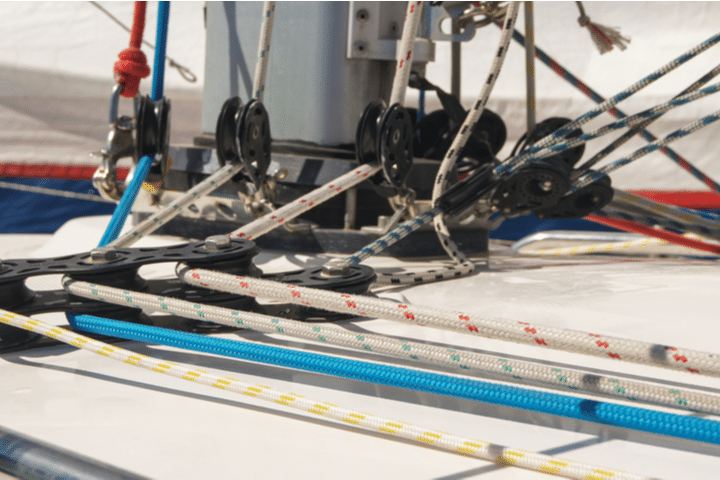
A Guide to the Different Parts of a Sailboat

Table of Contents
When you use Boatsetter, you have the opportunity to choose from a myriad of different sailboat rentals from all over the United States and beyond . A sailboat is a perfect way to relax on the water, either on a solo adventure or on an excursion with friends and family.
When you rent a sailboat with Boatsetter, you will have the option to book a captained sailboat to enjoy your day out on the water or book bareboat to hone your sailing skills. Either way, you may be interested in the intricacies of a sailboat and its different parts. If this sounds like you, you have come to the right place. In this article, we go in-depth about the different parts of a sailboat so that you can be more knowledgeable about whatever boat you may choose and come away from reading this feeling more confident about the whole sailing experience.
A basic sailboat is composed of at least 12 parts: the hull , the keel , the rudder , the mast, the mainsail, the boom, the kicking strap (boom vang), the topping lift, the jib, the spinnaker, the genoa, the backstay, and the forestay. Read all the way through for the definition of each sailboat part and to know how they work.
Explore sailboats for rent near you or wherever you want to go
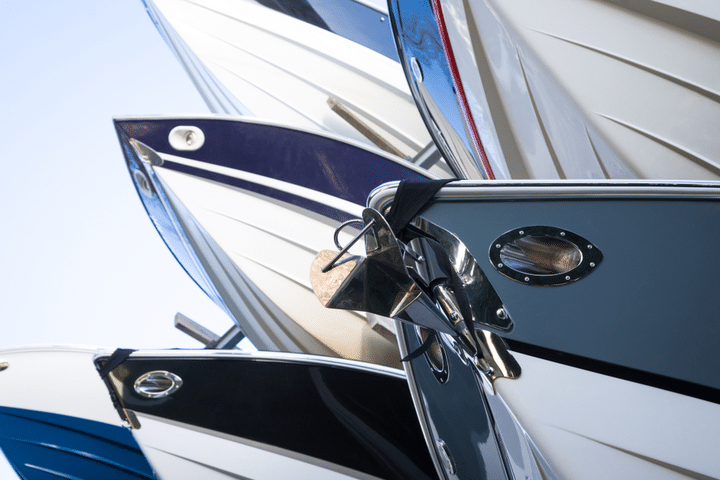
In short, the hull is the watertight body of the ship or boat. There are different types of hulls that a sailboat may have, and these different hulls will often affect the speed and stability of the boat.
Displacement Hulls
Most sailboats have displacement hulls , like round bottom hulls, which move through the water by pushing water aside and are designed to cut through the water with very little propulsion. The reason these are called displacement hulls is that if you lower the boat into the water, some of the water moves out of the way to adjust for the boat, and if you could weigh the displayed water, you would find that it equals the weight of the boat, and that weight is the boat’s displacement. One thing to know about displacement hulls is that boats with these hulls are usually limited to slower speeds.
Planing Hull
Another type of hull is a planing hull. These hulls are designed to rise and glide on top of the water when enough power is supplied. When there is not enough power behind the boat, these boats often act as displacement hulls, such as when a boat is at rest. However, they climb to the surface of the water as they begin to move faster. Unlike the round bottom displacement hulls, these planing hulls will often have flat or v-shaped bottoms. These are very common with motor-driven water vessels, such as pontoon boats, but they can also be found on smaller sailboats which allow them to glide quickly over the water.
Finally, sailboats can differ depending on the number of hulls that they have. There are three options: monohulls (one hull), catamarans (two hulls), and trimarans (three hulls).
Monohulls , which have only a single hull, will usually be the typical round bottom displacement hull or occasionally the flat bottomed or v-shaped planning hull. Catamarans have two hulls with a deck or a trampoline in between, with the extra hulls providing increased stability. Finally, trimarans have three hulls — a main hull in the middle and two side hulls used for stability. These trimarans have gained popularity because of their excellent stability and ability to go at high speeds.
When evaluating a sailboat , it is important to pay attention to the type of hull that the boat has because the type of hull a sailboat has can drastically change the sailing experience, especially when it comes to stability and speed.
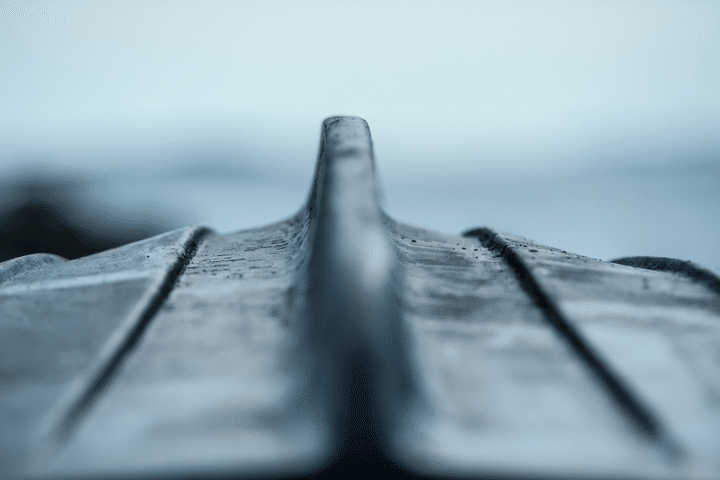
All sailboats have a keel, a flat blade sticking down into the water from the sailboat’s hull bottom. It has several functions: it provides counterbalance, life, controls sideways movement, holds the boat’s ballast , and helps prevent the boat from capsizing. When a boat leans from one side to the other, the keel and its ballast counteract the movement and prevent the boat from completely tipping over.
As with hulls, there are a number of different types of keels, though the two most common types of keels on recreational sailboats are the full keel or the fin keel. A full keel is larger than a fin keel and is much more stable. The full keel is generally half or more of the length of the sailboat. However, it is much slower than the fin keel. A fin keel, which is smaller than the full keel, offers less water resistance and therefore affords higher speeds.
A more recent feature on sailboats is the “winged keel,” which is short and shallow but carries a lot of weight in two “wings” that run sideways from the keel’s main part. Another more recent invention in sailing is the concept of the canting keels, which are designed to move the weight at the bottom of the sailboat to the upwind side. This invention allows the boat to carry more sails.
The Rudder
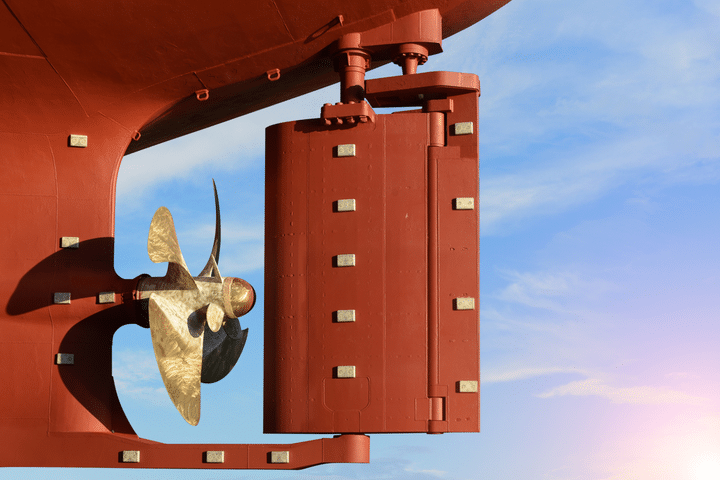
A rudder is the primary control surface used to steer a sailboat. A rudder is a vertical blade that is either attached to the flat surface of the boat’s stern (the back of the boat) or under the boat. The rudder works by deflecting water flow. When the person steering the boat turns the rudder, the water strikes it with increased force on one side and decreased force on the other, turning the boat in the direction of lower pressure.
On most smaller sailboats, the helmsman — the person steering the boat — uses a “ tiller ” to turn the rudder. The “tiller” is a stick made of wood or some type of metal attached to the top of the rudder. However, larger boats will generally use a wheel to steer the rudder since it provides greater leverage for turning the rudder, necessary for larger boats’ weight and water resistance.
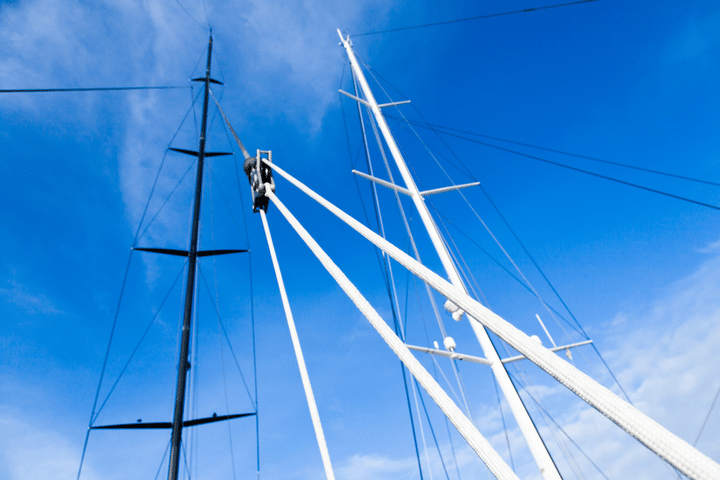
The mast of a sailboat is a tall vertical pole that supports the sails. Larger ships often have multiple masts. The different types of masts are as follows:
(1) The Foremast — This is the first mast near the bow (front) of the boat, and it is the mast that is before the mainmast.
(2) The Mainmast — This is the tallest mast, usually located near the ship’s center.
(3) The Mizzen mast — This is the third mast closest to the stern (back), immediately in the back of the mainmast. It is always shorter than the mainmast and is typically shorter than the foremast.
The Main Sail
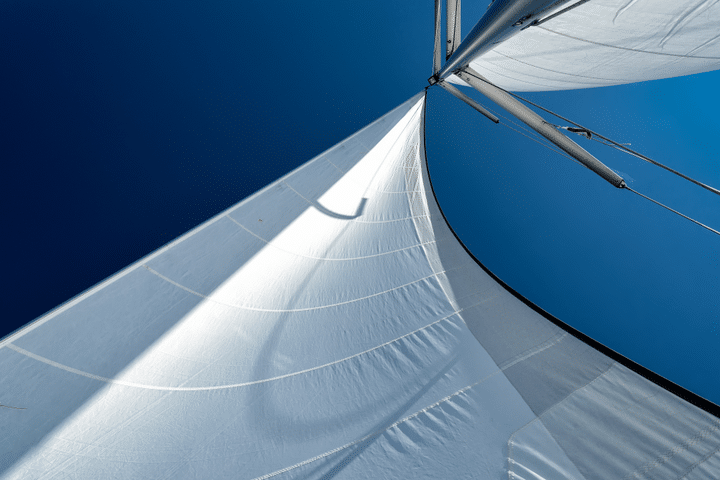
The mainsail is the principal sail on a sailboat, and it is set on the backside of the mainmast. It is the main source that propels the boat windward.
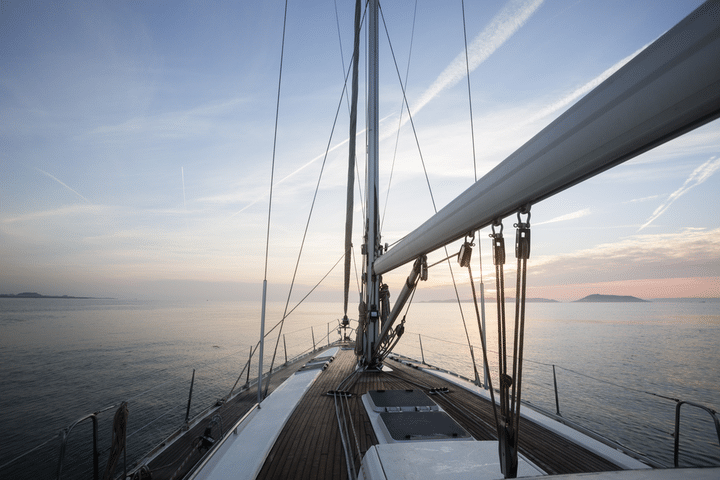
A boom is a spar (a pole made of wood or some other type of lightweight metal) along the bottom of a fore-and-aft rigged sail, which greatly improves the control of the angle and the shape of the sail, making it an indispensable tool for the navigation of the boat by controlling the sailes. The boom’s primary action is to keep the foot (bottom) of the sail flatter when the sail angle is away from the centerline of the sailboat.
The Kicking Strap (Boom Vang)
The boom vang is the line or piston system on a sailboat used to exert a downward force on the boom, enabling one to control the sail’s shape. The vang typically runs from the base of the mast to a point about a third of the way out the boom. It holds the boom down, enabling it to flatten the mainsail.
The Topping Lift
The topping lift is a line that is a part of the rigging on a sailboat, which applies an upward force on a spar (a pole) or a boom. Topping lifts are also used to hold a boom up when it’s sail is lowered. This line runs from the free end of the boom forward to the top of the mast. The line may run over a block at the top of the mast and down the deck to allow it to be adjusted.
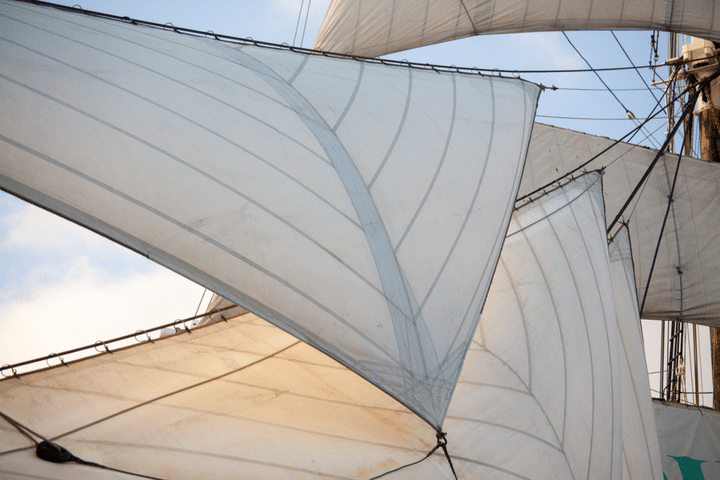
A jib is a triangular staysail set ahead of the foremost mast of a sailboat. Its tack is fixed to the bowsprit, the bow, or the deck between the bowsprit and the foremost mast. Jibs and spinnakers are the two main types of headsails on modern boats.
The Spinnaker
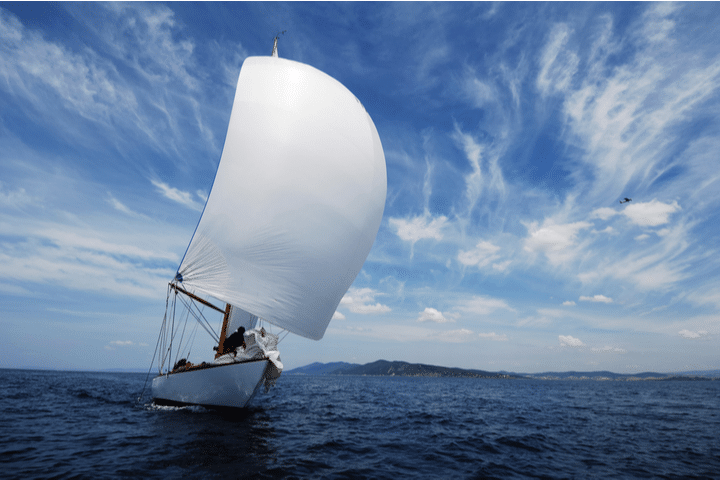
A spinnaker is a type of sail designed specifically for sailing off the wind from a reaching downwind course. The spinnaker fills up with wind and balloons out in front of the sailboat when it is deployed. This maneuver is called “flying.” The spinnaker is constructed of very lightweight material, such a nylon fabric and on many sailing vessels, it is very brightly colored.
Another name for the spinnaker is the “chute” because it often resembles a parachute, both in the material it is constructed from and its appearance when it is full of wind.
People often use the term genoa and jib as if they were the same thing, but there is a marked difference between these two types of sails. A job is no larger than a foretriangle, the triangular area formed by the mast, the deck or bowsprit, and the forestay. On the other hand, a genoa is larger than the jib, with part of the sail going past the mast and overlapping the mainsail. These two sails, however, serve very similar purposes.
The Backstay
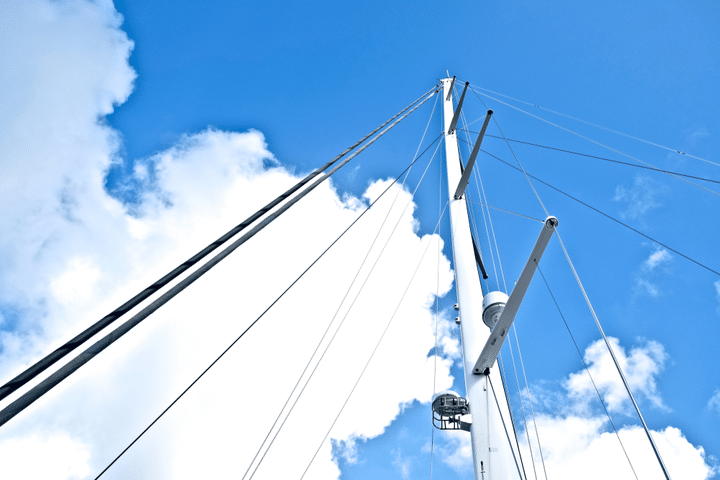
The backstay is a standing rigging that runs from the mast to the transom (the vertical section at the back of the boat), counteracting the forestay and the jib. The backstay is an important sail trip, control and directly affects the mainsail’s shape and the headsail.
There are two general categories of backstays:
1) A permanent backstay is attached to the top of the mast and may or may not be readily adjustable.
2) A running backstay is attached about two-thirds up the mast and sometimes at multiple locations along the mast. Most modern sailboats will have a permanent backstay, and some will have permanent backstays combined with a running backstay.
The Forestay
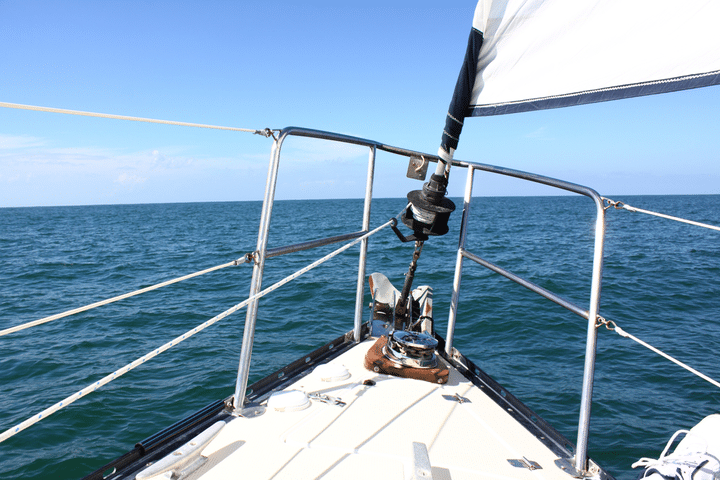
A forestay is a piece of standing rigging that keeps the mast from falling backward. It is attached at the very top of the mast, or at certain points near the top of the mast, with the other end of the forestay being attached to the bow (the front of the boat). Often a sail, such as a jib or a genoa, is attached to the forestay.
A forestay might be made from stainless steel wire, stainless steel rod or carbon rod, or galvanized wire or natural fibers.
Parts of a sail
Sails are vital for sailboats, made up of complex parts that improve performance and maneuverability. In this section, we’ll take a closer look at the different parts of that make up the sails.
Luff – The luff is a vertical sail part that maintains its shape and generates lift by interacting with the wind. It attaches securely with a bolt rope or luff tape for easy hoisting.
Leech – The leech controls air flow and reduces turbulence. Battens or leech lines are used to maintain shape and prevent fluttering.
Foot – The foot of a sail connects the luff and leech at the bottom edge. It helps define the sail’s shape and area. The outhaul is used to adjust its tension and shape.
Head – The sail’s head is where the luff and leech meet. It has a reinforced section for attaching the halyard to raise the sail.
Battens -The b attens are placed horizontally in sail pockets to maintain shape and optimize performance in varying wind conditions. They provide structural support from luff to leech.
Telltales – Sailors use telltales to adjust sail trim and ensure optimal performance.
Clew – The clew is important for shaping the sail and connecting the sheet, which regulates the angle and tension, producing energy. It’s located at the lower back corner of the sail.
Sailing is a favorite pastime for millions of Americans across the country. For some, there is nothing better than gliding across the water propelled by nothing more than the natural force of the wind alone. For both experienced and non-experienced sailors alike, Boatsetter is the perfect place to get your ideal sailboat rental from the mouthwatering Florida keys to the crystal blue waters of the Caribbean .
Smaller sailing boats are perfect for a single day out on the water, either by yourself or with friends and family. In comparison, larger sailing boats and sailing yachts can allow you days of luxury on longer excursions full of adventure and luxury.
Whatever your sailing dreams are, it is always good to know, for both the experienced sailor and the novice, all about the sailboat’s different parts. In this article, we learned all about the boat’s hull, the keel, the rudder, the mast, the mainsail, the boom, the kicking strap (boom vang), the topping lift, the jib, the spinnaker, the genoa, the backstay, and the forestay, which make up the basic parts of any sailboat you might find yourself on.
About us
Boatsetter is the go-to app for boat rentals and on-water experiences. Whatever the adventure, we’ve got a boat for that—Set sail , start the party , go yachting , make your trophy catch , and hone your watersports skills! Download the Boatsetter app ( App Store | Google Play ). Make sure to follow @boatsetter on Instagram, and tag us in all your boat day pictures for the chance to be featured.
Rent. List. Share—Only at Boatsetter

Boatsetter empowers people to explore with confidence by showing them a world of possibility on the water. Rent a boat, list your boat, or become a Boatsetter captain today.
Browse by experience

Explore articles
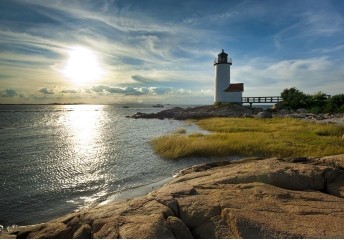
Let These 5 Lighthouses Spark Your Next Adventure
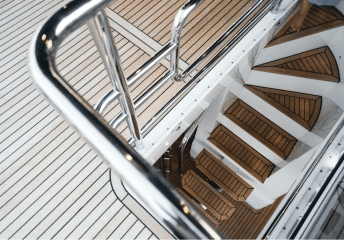
Boat Flooring Options
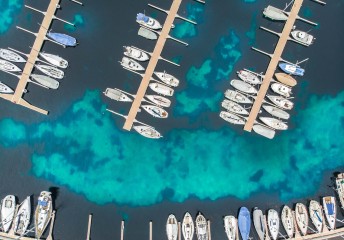
Make Your Boat Listing Shine - Let's Talk About Pricing
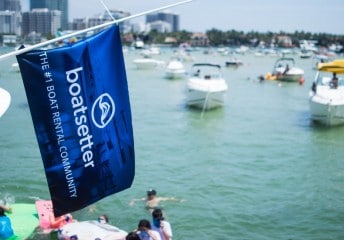
Make Your Boat Listing Shine: Reviews are Key

Sailboat Keel Types: A Complete Guide

Last Updated by
Daniel Wade
June 15, 2022
A keel is a very important part of a sailboat, crucial to its stability and ability to sail upwind. This article will discuss the fundamentals of all keels down to the details of the best keel for your boat. We will answer questions including what it does, what it's made of, and even some problems that a keel can cause. By the end of this article, you will be an expert on all things keels!
Table of contents
What Is a Keel?
A keel is the robust underwater centerline of a boat, and often extends into a long, hydrodynamically shaped blade.. It can vary in size and shape depending on the make and model of the boat. But, generally, it will look very much like a fin. If you imagine the fin on the underside of a surfboard you will have a pretty good idea of what it looks like under the boat.
It is crucial to helping with steering and control. The word keel itself comes from Norse and Dutch roots. The word simply means a structural component of the boat. You may have heard the term keel-haul, where pirates would drag someone underneath the boat across its keel. This is pretty barbaric, but it shows just how long a keel has been an important part of the boat. From Vikings to pirates to modern sailboats it has always remained an important part of a sailboat.
What is a keel made of?
A keel will typically be made of whatever the rest of the hull is made of. If the boat is wooden, it will most likely have a wooden keel. If the boat is metal, the keel will be metal, and so on. Sometimes, particularly on fiberglass boats, the core of a keel will be reinforced with lead or a similar ballast while the outside is covered with fiberglass.
The keel needs to be strong enough to withstand a lot of pressure and strain. Traditionally Viking sailing boats would have a wooden keel with some metal plating on it. Casting metal was tedious so putting it on your boat was seen as a waste. Traditional wooden sailing boats, like you would imagine pirates sailing, would also have a wooden keel. It would be made from thick hardwood like oak and could also be metal plated.
Since it is used to control the direction it must brunt the force of the change of direction. If you imagine a boat turning sharply, there will be a lot of pressure on the side that is on the outside of the turn. The hull of your boat will stand up to this pressure easily, as it is very large and very strong. The keel must be strong enough to withstand this too. The keel also can drag on the ocean floor or the boat ramp as the boat is lowered into the water. For this reason, it needs to be strong enough to hold up to the weight and pressure of the boat too. If it were made of plastic it would break every time you brought the boat in and out of the water.
What does a keel do?
The keel is there primarily for stability and guidance. The keel provides all sorts of benefits to the boat. It improves the righting moment and controls the boat’s sideways movement. The keel will also typically hold the boat’s ballast. The ballast keeps the boat weighed down and helps prevent capsizing. The ballast is typically made of lead, sand, or water.
Keels can be fixed or moveable. Some keels can be removed completely or may just retract slightly so they aren’t damaged when the boat enters or exits the water. When a boat leans to one side, because it is turning or there is strong wind/waves, the keel provides the righting moment that keeps the boat from flipping. On larger boats, it is designed to be so heavy that ig will be able to recover a boat from almost any angle of heel. Without a keel, your boat may tip too far or roll completely. On bigger ships, this can be disastrous. In its ability to prevent this alone, the keel is one of the most important parts of the ship.
Does my sailboat need a keel?
Yes, you do need a keel. Pretty much all sailboats have a keel, with exceptions for multi-hulled and/or smaller boats.
In the case of catamarans, the very design principles that lead to the dual-hull design render the keel obsolete. The stability introduced by the outrigged, dual-hulls replaces the necessary righting moment from the keel. Because almost all the structure of a catamaran is between the two hulls, unlike a monohull which builds out from and around its centerline, there is not a lot of weight pressing out to flip the boat. Related to this, since most catamarans have the length of their hulls pressing into the water, the steering force normally placed on a keel is distributed across the length of the two hulls, which additionally will carry their own ballast.
On smaller dinghies, a small swinging centerboard or daggerboard will suffice to play the role of a keel. The centerboards can be big enough to keep the boat flowing nicely through the water without the need for a large keel. Additionally, it is not a disaster for a small sailing or racing dinghy to capsize, as they are designed to do so and recover rather easily, so the ballast from the keel is also not terribly necessary.
If you have a motorboat you wouldn’t need a keel, unless it is a very large container ship or military vessel. The reason being that they are outboard propelled. The leg provides enough stability on its own. This is only the case with full plane powerboats. Displacement (even semi-displacement) craft will still need a keel of sorts for stability purposes.
What are some downsides to having a longer keel?
If you have a long keel that doesn’t retract or detach, you may have some problems coming in or out of the water. The keel extends far below the bottom of the boat, so if you are bringing your boat up or down a boat ramp you may find that it scrapes on the bottom. If you are not careful, you may damage the keel rather badly.
Since the keel is made of metal, wood, or fiberglass it can bear the brunt of the weight quite well. If you are putting your boat in the water and cannot retract the keel, it is a good idea to go as far into the water as possible before taking your boat off its trailer. The deeper you are in the water when the boat is released the better.
Are there any nautical traditions about the keel of the boat?
The keel is interestingly very important when it comes to boat or shipbuilding.
Traditionally, the keel is one of the first parts of the ship to be made, as the rest of the ship must sometimes be built around it. This tradition is called “laying the keel,” and is a momentous occasion. It is essentially the boat’s birthday. The boat’s age is dated from this moment, and there is also typically a celebration of sorts. This goes back to the days of seafaring exploration. The only day more important in a boat’s life is the day it is finally launched.
Can other types of boats have keels?
Yes! Many other types of boats have keels, not just sailboats. A good example would be a big shipping trawler. These trawlers are very large and need all the help they can get to stay balanced. Because of this, they often have what’s called a bar keel. This is a large rectangular piece of metal that runs along the bottom of the boat’s hull. It is very thick and heavy. The idea is that it gives the boat some more directional control when steering.
Furthermore, it helps keep the trawler balanced when out at sea in rough conditions. The extra weight keeps the boat’s center of gravity as low as possible. This makes tipping the boat almost impossible. It does slow it down a bit, but that is a small price to pay for increased safety.
Huge cargo ships also have a keel, though it is different from a bar. Their keel is known as a plate keel. It is essentially another layer of the boat under the hull. Its only purpose is added weight and protection. A plate keel runs along the centreline of the bottom plate of the ship so the weight is all concentrated in the lowest place possible. This kind of keel works similarly to how the spine of a person does. It keeps your back strong and as straight as possible.
How important is it to keep my keel clean?
It is very important to keep your keel clean, just as it is important to keep the rest of your hull clean.
For any boat kept on the water rather than hauled out every day, there is always the need to clean the hulls and keels of any barnacles and other sea growth. Barnacles not only affect your performance, but can, in the long run, greatly increase your maintenance costs if not regularly addressed.
To do so, you have to do what is known as scraping. Scraping is the process of physically scraping off all the barnacles and other sea life that has attached itself to the underside of your boat. Many marinas offer this service, but you can do it on your own with a basic plastic paint scraper and a wetsuit. When you do this, it is key to get all the way down to the bottom of the keel and all across the hull. If you don’t scrape it off, it can start to erode your boat away over time. It can also slow you down.The barnacles and other marine life create a very rough bottom. This creates more friction and will reduce your speed more and more the worse it gets.
It is important to check with your port authority before you start scraping. Scraping is not allowed in some places as you may introduce invasive species to the area. It depends where you have been more than where you are. If you sailed from New York to Chicago, you will be fine. If you sailed from Cuba to New York, probably not so much.
How to maintain a sailboat keel
As mentioned above, it is important to scrape your keel from time to time. While racing boats will actually do this before every day at an event, it is at least a good idea for you to do this a couple of times a season. A great time to do this is when you plan on applying that season’s bottom paint, though anytime you plan to go on your boat is a good excuse to maintain!
You may want to cut off any of the kelp and seaweed that wraps itself around the keel. This is more likely to happen if you have a fin keel. If you do find that there is a lot of kelp and seaweed wrapped around it, you will want to buy yourself a kelp cutter. Unfortunately, the only way to cut the kelp off without taking the boat out of the water is to dive in and do it yourself. It is a good idea to do this in shallow-ish water with the proper flags displayed to inform other boaters that there is someone in the water. Swimming around under your boat, even when it isn’t moving, can be dangerous.
What do I do if my keel breaks at sea?
It is very rare for keels to just break off. It is even rarer at sea. After all, what is going to break it off? The only way a keel will break off ordinarily is if you run aground.
If you should accidentally make your way into shallow waters and break your keel off it is a good idea to set sail for home. You will manage well enough in the short term but will struggle over time. You are far more likely to capsize without the keel keeping you balanced.
If you have a detachable keel it is a good idea to keep a replacement. If one breaks off, you can just install the spare one. This isn’t the easiest thing to do at sea in rough conditions, but it is possible. Make a judgment call using your common sense whether it is worth the risk or not.
Another reason your keel might break or come loose is if the keel bolts come out. These bolts are what holds the keel in place. If you happen to have a keel held on by bolts, then doing proper maintenance is even more important. If the bolts come loose, the keel can come loose.
Since the keel is typically welded on to the boat’s hull the chances of it coming off completely are slim to none. Most often, running aground on a sandbar or anything short of an incredibly rocky bottom in heavy weather will crack off a piece or severely bend the keel, which requires a major repair. If you do notice that the keel is loose, you are better off taking it back to the marina. The bolts may not come off without using some machinery, meaning you might have to take your boat out of the water. If your keel starts to rust, you may need to speak to a professional.
What are the different keel types?
Now you know what a keel is, what it does, why it is important, and how to care for one it is time to learn about the specific types of keels. Big trawlers and cargo ships have bar or plate keels, but sailboats do not. Here are the 6 different types of keels typically found on sailboats and their purposes:
The full keel is one of the most common types of the keel that you are likely to see on a sailboat. A full keel runs from end to end of the boat lengthways. A full keel, as the name implies, runs almost the entire length of the boat. At a minimum, it must run 50% of the length of the boat. A full keel is one of the most stable keel types, which is why it is so common. Full keels are also safer should you run aground. If a boat with a full keel should come ashore, it will cut its way through the sand and eventually land on its side. Whether you are grounding your boat intentionally or not, your boat will have far better odds of surviving the ordeal with a full keel.
A fin keel is similar to a full keel, just shorter. There may be one or two fin keels along the length of the boat hull. A fin keel is defined by being less than 50% the length of the boat. The fin keel works almost entirely the same way that a shark's fin does. When you wish to turn, the keel provides the resistive force that keeps you turning. This means that it essentially acts as your tires going into a turn. Whereas a full keel is essentially just a long fin, a fin keel has very different benefits. A full keel is more stable and safer overall. A fin keel is sleeker, smaller, and most importantly makes you faster. Most racing sailboats have fin keels.
A bulbed keel is very similar to a fin keel. In fact, it is possible to make a bulb keel by shaving off part of a fin keel and attaching a bulb. Once the keel has been made substantially shorter, the bulb is fitted. The bulb is shaped similarly to how a torpedo would be on a submarine. This keel works the same as a fin keel does, offering a slightly more stability without sacrificing speed. The biggest difference between a bulb and a fin keel (besides shape and length) is where they are used. Bulb keels are most commonly used in places with very shallow waters and lots of rock/shale/coral outcrops. Somewhere like the Caribbean would be the perfect place for a bulb keel. The rounded bulb bounces off the rocks and is less likely to break off. It just isn’t going to be as quick as if you used a fin keel.
The wing keel is another alternative to your standard fin keel. Just like the bulb keel, a wing keel is an extension to the standard fin keel with an extra fitting at the bottom. A wing keel is far more streamlined than a bulbed one, at the expense of being more susceptible to breaking. A wing keel looks very similar to the tail of an airplane. It works the same way, too. The water can pass by either side of the wings, allowing you to adjust your course easily. But, a wing keel does have one major problem. If you do run aground, digging out a wing keel can be very difficult. Whereas digging out a standard fin is as simple as scraping sand away from the sides of it, a wing keel must be dug out completely. The wings act like little shovels and wedge themselves into the sand. These are generally limited to higher performance racing classes.
Centerboard Keel
A centerboard keel works similarly to a fin keel but it can retract slightly. It works by having a dagger that folds out downwards. When you are sailing, the dagger protrudes outwards and offers you all the stability and balance of a fin keel. When you are in shallow water, the dagger can be retracted upwards, essentially shortening the keel temporarily. This should be done when you are sailing in shallow waters or removing the boat from the water entirely using a boat ramp. Some centerboards work on a loose hinge. When the boat is sailing along, the dagger is out and the fin works as normal. If you should bump into something though, like some shallow rocks, the hinge would push the daggerboard back inside. This stops the keel from breaking, instead, it just moves out the way. This only works if you are only just deep enough. If you are in very shallow water you would just break the centerboard off.
Canting Keel
A canting keel also works on a hinge. Instead of working end to end, it works port to starboard. When the boat turns a corner, the canting keel swings from side to side. This allows the boat to maximize its balance and speed. Eventually, this will become the norm in racing. But at the moment it is still quite experimental. The biggest downside is that the hinge works on hydraulics, and hydraulics can fail. If they should fail at sea there is very little you can do to repair them. Once they have perfected these canting keels, they will move first into the racing classes and high performance boats, then to all new cruising boats as boatbuilders improve the technology. .
Hopefully, you now have a good idea about what a sailboat keel is,how it works, why it is so important, and, of course, all the different types. Chances are, when you buy a sailboat , the keel it has is going to be at the bottom of your list of priorities. That being said, if you are planning on sailing somewhere in particular, it is a good idea to think about what keel type you are using. Replacing them doesn’t have to be expensive, but you can go a long way to saving yourself that money either way by being prepared for your home waters!
Related Articles
I've personally had thousands of questions about sailing and sailboats over the years. As I learn and experience sailing, and the community, I share the answers that work and make sense to me, here on Life of Sailing.
by this author
Learn About Sailboats
Most Recent

What Does "Sailing By The Lee" Mean?
October 3, 2023

The Best Sailing Schools And Programs: Reviews & Ratings
September 26, 2023
Important Legal Info
Lifeofsailing.com is a participant in the Amazon Services LLC Associates Program, an affiliate advertising program designed to provide a means for sites to earn advertising fees by advertising and linking to Amazon. This site also participates in other affiliate programs and is compensated for referring traffic and business to these companies.
Similar Posts

Affordable Sailboats You Can Build at Home
September 13, 2023

Best Small Sailboat Ornaments
September 12, 2023

Discover the Magic of Hydrofoil Sailboats
December 11, 2023
Popular Posts

Best Liveaboard Catamaran Sailboats
December 28, 2023

Can a Novice Sail Around the World?
Elizabeth O'Malley

4 Best Electric Outboard Motors

How Long Did It Take The Vikings To Sail To England?

10 Best Sailboat Brands (And Why)
December 20, 2023

7 Best Places To Liveaboard A Sailboat
Get the best sailing content.
Top Rated Posts
Lifeofsailing.com is a participant in the Amazon Services LLC Associates Program, an affiliate advertising program designed to provide a means for sites to earn advertising fees by advertising and linking to Amazon. This site also participates in other affiliate programs and is compensated for referring traffic and business to these companies. (866) 342-SAIL
© 2024 Life of Sailing Email: [email protected] Address: 11816 Inwood Rd #3024 Dallas, TX 75244 Disclaimer Privacy Policy
You are using an outdated browser. Please upgrade your browser to improve your experience and security.

- Buy Tickets
- Join & Give
Pacific Voyaging: Keel and Rudder
- Author(s) Dr Stan Florek
- Category Science
- Published 22 January 2018
- Read time 2 minutes
- Share this page:
- Share on Facebook
- Share on Twitter
- Share on Linkedin
- Share via Email
- Print this page
Pacific Voyaging is a blog series consisting of stories related to indigenous maritime cultures in the Pacific Ocean.
When you see sails on the water you can be sure the boat has a keel and a rudder. Because without them the magnificent power of wind that bulges the sails would be lost. A boat without a keel and a rudder wouldn’t go where the skipper wishes to take her.
Sails are the only most visible part of sailing technology. Harnessing the wind is necessarily linked with directing the boat to its destination, even against the wind. In fact, sailing against the wind and independently of its capricious directions is an essence of sailing. The wind is to power the boat not to dictate destination.
The sail with keel and rudder is an essential sailing trio.
A keel is the bottom-most, sturdy structural “ridge” around which the hull of a boat (and ship) is built. It’s like a partially external backbone that runs along the centreline of the boat, from the bow to the stern. This ridge defines the longitudinal profile of the hull - it splits the waves in the front, gives the boat greater stability, and minimises its tendency to drift sideways.
Another type of keel, usually additional, is a broad thin blade affixed vertically to the hull’s bottom and entirely submerged in the water. Typically made of metal and it is heavy, to place the boat’s ballast as low as possible. Such a keel dramatically increases stability of a vessel and its resistance to drifting sideways. Most modern sailing yachts would have this keel, which also allows them to have a taller mast and bigger sails to propel these marvellous crafts – their normal speed would be about 5-7 knots (about 9-13 kilometres per hour - twice the speed of brisk walking) allowing them to cruise about 100-150 kilometres per day.

In sailing upwind, modern yachts can stay 5° diagonally to the wind. For this, and indeed for any sailing, the boat must have a rudder. This is another large blade, attached to the boat in such a way that it pivots, in a similar way as the front wheel of a bicycle, although at the back. When a sailor positions her boat close to the wind, the keel prevents it from drifting sideways (it always does a bit) and the rudder keeps the vessel on its course. If her destination was exactly in the direction of the wind, the sailor would change a tack every now and then, and in zigzagging, a little off the direction to the left and then to the right, it progresses forward.
A large paddle (or two) can be used as a rudder, as was the case in ancient Egyptian and Phoenician ships and in the boats of the Pacific indigenous sailors. In the Milne Bay province of Papua New Guinea, for example, a voyaging anageg (large canoe) would have a several metres long paddle ( kavavis ) for steering and to supplement the function of the keel, but a smaller steering paddle as well. The smaller paddle is inserted into the water at the right moment to make a finer correction in steering.
Some thousand years ago, boats with an outrigger appeared in Southeast Asia. It is not only a wondrous legacy of indigenous ingenuity but a tangible evidence of excellent comprehension of an art of sailing. An outrigger is usually understood to increase stability of a boat; a watercraft with single outrigger would typically position it windward. Yet, the outrigger’s float is like an additional parallel keel that fortifies the boat’s resistance to sideway drifting.
It appears that early dugout canoes (log boats) had limited room and technical means to form a significant keel. Using anageg as an example again, the bottom part of the hull is made of a single dugout log and often referred to as a keel; the upper part is made of horizontal planks, in two or three rows above each other, to increase the hull’s holding capacity. To get a keel ( wag ) with the desired curve, the Muyuw people of the Milne Bay not only select the most appropriate tree, but often nurture it to grow into the shape that best meets boat building requirements.
Outrigger boats of a similar kind helped Austronesian sailors to spread their culture, people and language across the entire insular Southeast Asia, and beyond across coastal Melanesia and its numerous islands big and small. About 3,500 years ago they settled in the Marianas Islands, some 2,300 kilometres of open ocean from the north Philippines, about 2,000 years ago they settled in Society Islands (Tahiti), about 1,000 years ago they reached South America, and only a few centuries latter populated remote Rapa Nui (Easter Island), Hawaii and Aotearoa (New Zealand), as well as Madagascar in the Indian Ocean, effectively completing human dispersal throughout the world, which began about 2 million years earlier.
A wag (keel) in Muyuw, like in Old English, refers to both keel and boat. The idea that a hull itself functions as a keel can be supported by the recognition that a systematic relationship exists between hull’s size, measured by waterline length, and its potential speed. In a nutshell, by doubling a hull's dimensions, the underwater area is squared, displacement is cubed and stability increases by the power of four. For example, a boat with about 8 metres waterline could sail just under 7 knots, while a boat with 16 metres waterline – over 9 knots (over 16 km per hour, close to an average cycling speed).
This could explain why a large round washing bowl would not be suitable for sailing; and neither would a wooden box. Although, a converted coffin, originally made for Queequeg, a fictional Polynesian harpooner, saved the life of Ishmael in the novel “Moby-Dick” by Herman Melville, we would not find many sailors recommending a watercraft of this kind.
Explanations:
A boat displacement is the volume of the underwater part of its hull – equivalent to the boat’s weight.
The waterline is the horizontal line where the hull of a boat meets the surface of the water – it is often used (among other variables) in estimating the hull speed.
Squared - a number multiplied by itself, for example, three squared: 3 x 3 equals 9.
Cubed - a number multiply by itself three times (raise to the third power), for example, five cubed: 5 × 5 × 5 equals 125.
Forth power or power of four - a number multiplied by itself four times, for example 4 × 4 × 4 x 4 equals 256.
Additional information:
High-performance modern sailing watercrafts can achieve speeds of 40 and 60 knots (over 70 and 120 km per hour).
The word “keel” originated from Old English ceol , Old Norse kjóll , meaning "ship" or "keel". Some scholars hold it to be the very first word in the English language recorded in writing – spelled cyulae by Gildas in his 6th century Latin work on the “Ruin and Conquest of Britain" in reference to three invading Saxon ships.
The Latin word for "keel" is carina and derived from it the term careen means to clean a keel, and the hull in general, for which purpose the ship was rolled on its side. Such cleaning was done at Careening Cove (at Milsons Point) of Sydney Harbour in early colonial days.
The word “rudder” has its origin in, variously spelled, but similar old English, German, Frisian and Dutch terms meaning paddle or oar.

The Australian Museum respects and acknowledges the Gadigal people as the First Peoples and Traditional Custodians of the land and waterways on which the Museum stands.
Image credit: gadigal yilimung (shield) made by Uncle Charles Chicka Madden

What Is A Rudder On A SailBoat and How Does It Work ?

You’ve seen the helm of a sailboat and heard people talk about the rudder, but what exactly is it? The rudder on a sailing boat is a device that steers the ship. On smaller boats, like dinghies or kayaks, this steering might be done with oars or paddles. But on larger vessels, you will see that there are two vertical boards called blades (or rudders) attached to either side of the sternpost at its base. These blades can pivot from side to side so they allow the boat to turn in any direction needed when steering by hand.
Rudders are basically the underwater parts of your boat that controls your direction.It is tough to maintain the steering without them, so, they are one of the most critical parts of your boat. Different types of rudders with various features make the boat work differently. Do you want very high performance but a fragile rudder? Do you want a good performance, however, a well-protected rudder? It all depends on where you sail, how you sail, and what you would be willing to compromise. This blog post will explain what a rudder is, how it works, what kind of rudder designs are available out there.
Table of Contents
- 1 Tiller or Wheel?
- 2 So what is a rudder?
- 3 How rudder works?
- 4 Rudder types on Sailbaots
- 5 Conclusion: It's like most things in life; it's a compromise
Tiller or Wheel?

Tiller : Smaller boats (under 30 ft) usually use a tiller to turn the rudder. Tiller is basically a wooden (sometimes aluminium or steel) stick attached to the top of the rudder rod. The more force needed to turn it is better to make the tiller longer to increase the moment arm. They are great for racing and also for solo sailing as you don’t need to stand to control and you can also be busy with other things like tacking while holding the tiller between your legs.
Wheel : The bigger boats usually have wheel instead of tillers. The wheel system works with additional shafts and gears to ease the movement of the rudder blade. Wheel also gives the sense of driving as the turning direction is the same as the boat turning direction, unlike the tiller.
So what is a rudder?

The rudder designs we are using today have evolved from the steering board that was used in ancient times. The steering board was usually mounted on the right-hand side to suit right-handed sailors. In time the steering board moved on to the centre line through a stock passing through the vessel, and a tiller was then attached to the stock, which allows sailors to control the rudder from the main deck. Surprisingly the rudder basics are kept the same over the years. A tiller or wheel connected to a rudder stock connects to a board/blade in different shapes and profiles that create the lift under the water.
How rudder works?

The rudder works by deflecting water flow. When the rudder blade is straight and parallel with the flow, it has no effect on the steering.

When the skipper turns the rudder this is what happens;

If the rudder blade is directed to another angle, the blade has to direct the water at an angle away from the boat to increase the pressure on narrowed angle side and decrease the pressure on the other side.

This pressure difference pushes the stern to the low-pressure direction. In this case, the boat will try to turn to the port side. This is basically how you steer a sailboat with the rudder. Not an easy task to master but fun nevertheless!
Rudder types on Sailbaots

Rudder on a Full-keel sailboat
Full-keel boats or modified full keel boats usually have this type of Rudder. These rudders are typically hinged to the aft edge of the keel to make a continuous surface, not to create any drag after the main keel. Engine propeller is usually positioned between the keel and the Rudder.
The main advantage of these type of rudders is the Rudder is well protected and strong. It is hinged at the top and bottom, which helps distribute the forces on the rudder blade through the keel. Also, Rudder or any other item cannot snag on. In case of grounding, the Rudder will always be protected. This means you will be able to maintain your steering even after grounding or an accident.
Because of design, this type of Rudder requires more considerable forces to move, significantly when speed is increased. This is the reason why old long boats rarely have tillers as it usually requires a lot of push.
Manoeuvrability is more rigid on these type of rudders as the propeller wash effect can be so little – especially with the full keel attached rudders with a propeller notch. But hey, full keel boat itself is another challenge for manoeuvring, right?
Spade rudder and balanced spade rudder
Today, most fin keel boats have a spade rudder which is basically an extension straight down from the aft hull suction. The rudder rod comes down through the hull into the rudder blade itself in a most efficient and force friendly way. It allows the entire Rudder to rotate around.
Excellent performance: Spade rudders are modern rudders often chosen by serial production boats by famous brands. They are usually tall and thin, which gives high aspect ratios that means a lot of lift and little drag as the longer the Rudder is, the bigger the drag is.
Less force: They don’t need a full keel or Skeg for mounting. As the rudder blade can be moved around a balanced rod, the forces are much less than the other rudders.
Fragile : As it is applicable for any optimum design, more performance means less durability. A spade rudder is a vulnerable rudder, especially to debris or objects in the water which can hit the Rudder and exert a force on the rudder rod, which is the only structural support. Even the water pressure when the sailboat falls off a wave can have a significant impact on the rod and create high stresses. If the rod is bent, the Rudder may also jam – so be aware!
Balanced spade rudder: In some designs, the rudder rod and the leading edge of the rudder blade are arranged in the most optimum way, so the forces during the steering are as less as possible. These balanced spade rudders usually have a slight gap between the hull and the rudder blade.
Skeg mounted Rudder
Some fin keel boats also may have Skeg mounted rudders. It is a compromise version between the two rudder types above.
In general, Fin keel boats give more performance comparing to the full keel or modified full keel sailboats. When the Rudder is placed more to the aft that gets more clean water, it will have better performance; however, you may have durability issues, as explained in the spade rudder section.
Designers over the years combined these two rudder types and came up with a solution called skeg mounted rudder .
Some designs include skeg construction right before the rudder blade. They also call it cruisers rudder . The idea is the Skeg (faux keel), which is firmly attached to the hull or part of it like the keel, protects the Rudder for any damage and provides a better connection in terms of the load distribution loaded. As you might guess, you give up little performance for better durability.
It has the same advantages and disadvantages when you compare it with the full keel rudder or spade rudder; however, it is known that the forces on the helm can be on the high side. This means it requires more power to turn the rudder blade, especially in heavy weather or high speed.
Outboard Rudder
The outboard rudders are mounted outside the hull on the boat’s stern (transom) with the hinges. The outboard rudders are usually provided with a tiller instead of a wheel as there is no rudder rod to control with any gears.
Outboard rudders don’t need any hole through the hull, which is excellent in case of damage. The Rudder can be removed or serviced while the boat is still in the water. Also, the strong hinges from the top and bottom (sometimes in the middle) provide great strength, like in the full keel rudders.
Like the spade rudders, outboard rudders are vulnerable to any object that may hit. The forces on the helm will also be high at high speeds during sharp turnings.
It can also be dangerous when docking the sailboat from the aft side as you may hit the Rudder itself to the shore.
Conclusion: It's like most things in life; it's a compromise
The type of Rudder on a sailboat has more to do with the keel than any other equipment on the boat. As I said, if you are a day sailor and like the high performance and even participating in races, you wouldn’t go for a full keel sailboat. If you are a cruiser and making long passages and want to feel comfortable, then a full keel reliable boat might be your choice. Whatever the rudder and skeg configuration, it is essential that the keel has a more significant draft than the Rudder and/or Skeg. This way, in the event of a severe grounding, the keel takes the hit. We have seen new rudders that actually have more draft than the boat’s keel; this is absurd! In the event of a grounding, and if the boat dries out, the keel and Rudder must be built strong enough to support the boat’s total weight without damage and in a relatively stable manner. For this to occur, there must be a reasonable surface area on the bottom of the keel (a bulb keel does well here, as in so many other areas), with a flat or nearly flat profile far enough forward and aft of the boat’s centre of gravity to stop the boat toppling over on its ends if, for example, it is laid up against a jetty. However, a wide, flat keel is undesirable (some wing keels fall into this category). If the boat runs aground parallel to a steeply sloping shoreline with the tide going out, it will want to lie down on the “downhill” side. This will lay it over far more than if laid down on the “uphill” side and exacerbate problems such as stowed gear falling around and wet-type batteries leaking. It also makes the boat vulnerable to flooding when the tide comes back in, particularly if any seas are running.
Sharing is caring!

Lisa Hayden-Matthews
- May 8, 2021
- No Comments
Related Posts
Popular pontoon boat accessories you would be sorry to not have., 30 pontoon decoration & party ideas for a boat parade, how much do jet skis weigh (you would be surprised), how long does it take to learn to sail (not as long as you probably think), how to surf : everything you need to know.
Subscribe To Our NewsLetter!
FINANCIAL & MEDICAL DISCLOSURE
The HobbyKraze is a participant in the Amazon Services LLC Associates Program, an affiliate advertising program designed to provide a means for website owners to earn advertising fees by advertising and linking to amazon.co.uk and any other website that may be affiliated with Amazon Service LLC Associates Program. As their Associate, we earn from qualifying purchases.
The information written on this website is not medical advice, nor has it been endorsed by medical health professional(s). All content on this site is for informational purposes only.
We are independently owned and the opinions expressed here are our own
453, S Spring Street, Ste 400 PMB1061
Los Angeles, CA 90013
Accounts Dept : [email protected]
General Enquiries: [email protected]
Publishers Relations: [email protected]
Tel: +1 (213) 457-3776
Explore The World, Unleash Smart Hobbies & Increase The Zest For Life In You!
Site Structure EarthlyChirp
©2023 HobbyKraze. All Rights Reserved.

Sailboat Keel Types: Pros And Cons 2024
Sailboats are highly versatile vessels that offer a unique form of entertainment and leisure, yet before you can truly unlock their potential, it is important to gain an understanding of all the different keel types available—each providing its own advantages.
Whether you’re new to sailing or an experienced sailor looking to ride a different wave, this post will provide you with insight into all the various sailboat keel types and highlight the advantages they present.
In this blog post, we’ll explore the advantages of different keels, as well as discuss the best route for outfitters trying to decide which is right for them.
From fin stabilizers to centerboards, let’s dive right in and explore which one best suits your boating needs!

Table of Contents
Centerboard keel, what is a sailboat keel, what is the purpose of a keel on a boat, sailboat keel materials, can you sail without a keel, how to look after your keel, what to do if your keel breaks at sea, sailboat keel types and their advantages.

From improving maneuverability in tight spaces to increasing stability when combating choppy seas, understanding how each type works can give you the edge you need to brave any challenging conditions that come your way.
Here are the most common types of sailboat keels and their advantages and disadvantages.

A full keel is one that runs pretty much the whole length of the sailboat.
This is one of the most stable types of keel, and is popular with offshore cruisers looking for a solid, rugged sailboat.
A full keeled sailboat will usually fare better in heavy weather. They tend to track better in big waves and there is less risk of you losing the keel compared to other keel types.
Another advantage of full keeled sailboats is that they are safer to run aground (if you find yourself in that unfortunate situation), and the rudder is pretty well protected.
The disadvantages of full keels are that they don’t maneuver well in reverse. This can be a big problem when coming into moorings astern, especially in the Med where stern to mooring is popular. They also tend to need more power to tack effectively.
Full keels are usually also deep keels (though you can get full keeled sailboats with shallow keels too). It’s really important to consider the draft of a boat before buying, because you’ll want to be sure you can cruise it in your desired waterways.
How to tie a sailboat to a mooring ball

Fin keels are probably the most popular type of keel on modern boats, and you’ll see many of them around a boat yard.
Fin keels look how they sound, like a fin underneath the boat. They tend to hang quite low to make up for a smaller amount of ballast, so boats with a fin keel usually have a deeper draft.
There are many advantages to fin keels, explaining why they are so popular today. They tend to outperform full keeled points on most points of sail, especially close to the wind where they can point closer and sail faster.
They handle more easily under power and can go astern, making mooring easier. They are also more agile when tacking.
The main disadvantages to a fin keel are that they tend to be less stable. They will power up quickly and heel quickly, so reefing at the right time is paramount.
Another concern from many sailors is the fact that fin keeled boats are bolted on. If those bolts aren’t regularly inspected and maintained then they can fail, resulting in your sailboat losing its keel with catastrophic results.
Because they tend to have a deeper draft there is more possibility of them grounding, and more possibility of a grounding having serious consequences.
Although these safety concerns are sometimes overdramatised by the sailing community (plenty of people cross serious oceans in fin keeled boats every year), they are something to bear in mind.

A bulb keel is very similar to a fin keel, only it has additional ballast at the end, usually in the shape of a bulb or teardrop which is where it gets its name.
The ballast improves stability, using the distance between force and counterforce as a lever.
The benefits of a bulb keel are very similar to that of a fin keel, but you’re likely to find increased comfort and stability and better performace.
The cons are also very similar to fin keels, and you’ll want to check the keel bolts carefully before you purchase a boat with a bulb keel, and make sure you’re on top of regular maintenance too.

A wing keel is again very similar to a fin keel, but with a horizontal fin at the tip of the keel that looks a little like wings.
The design of this keel gives most of the same advantages of a fin keel, but the edge it has over it is the fact it can have a shallower draft, meaning you can sail in shallower waters. These boats tend to be popular for river or lake sailing for this reason.
The cons of this design are that you will lose some windward performance compared to the fin keeled sailboats, and you might find the wing creates drag and therefore a slower performance overall.

A bilge keel boat has two keels, or twin keels placed off centre. They are a popular type of keel although less common than fin and full keels.
One of the big advantages of these types of sailboat keel is that they allow the boat to be beached and rest on the keels. This also makes running aground safer, especially compared to fin keeled boats.
Bilge keels have double the wetted surface area, increasing the overall comfort of the boat and its directional stability. They also sail pretty well to windward.
Compared to the fin keel, bilge keeled sailboats tend to be slower, especially the older models. What you lose slightly in speed you tend to make up for in comfort.
Sailboats with a centreboard keel can give you the best of both worlds. With a keel that retracts, usually resting on a hinge that can be raised or lowered through a slot in the hull, it can increase or reduce the draft of a sailboat.
You will find sailboats that have ballasted lifting keels, and ones where the centreboard isn’t essential to the stability of the boat and carry hardly any weight.
With the centreboard down, the idea is that the sailboat will track better to wind and give you more maneuverability. It should make your boat behave similarly to a full keeled sailboat.
With the board up, you will be able to reach much shallower waters. It also means the boat is faster under motor alone with less drag through the water, and often a more effective downwind sailor too. Some of the best shallow draft liveaboard sailboats have lifting keels.
The disadvantages of a lifting keel are that you will lose some performance, especially when sailing upwind.
There is also the safety aspect of more working parts that need to be maintained, and with boats that have a ballasted lifting keel the danger of losing the keel is even more prevalent.

A sailboat keel is the fin that hangs underneath a sailboat like a dagger, providing stability against strong sideways forces of wind.
The design is crucial to hold the boat upright and make sailing tack easier, with its depth and shape involving meticulous calculations of size, weight, center of gravity, providing buoyancy, and other features.
On modern sailboats, the keel may be made out of cast iron or steel for extra strength, while traditional boats would opt for a design comprised of lead or copper.
Regardless of its form though, it proves to be an absolute must-have device on any ship meant to travel on wind power alone.

Sailboats are designed to take advantage of the wind, allowing you to traverse the seas with relative ease. But what makes a sailboat so efficient? Well, it all comes down to its keel: the long, usually slightly curved structure that extends below your boat’s hull and helps keep it stable.
The keel on a boat is an integral part of its design and provides many essential functions.
Acting as an anchor, the keel helps to keep the vessel in place regardless of wind and current conditions.
It also helps to increase the stability of the boat by lowering its center of gravity and distributing weight more evenly across it. This improves the handling of the boat, which can be especially important in rough waters.
The keel holds the ballast for the sailboat, keeping it from tipping over and meaning it can right itself if it does capsize.
All told, a boat’s keel plays a very important role in making sure that its passengers have a safe, stable ride out on open water.

Most keels are made from the same material as the boat itself – usually fibreglass, wood or steel.
They will then also contain a ballast. A heavier material that gives the boat its righting ability, and prevents it from capsizing easily in heavy seas.
The ballast in sailboat keels are traditionally created from iron or lead to give the boat stability and balance in the water.

The answer to this question is, it depends. There are sailboats that have been designed without keels, such as sailing dinghies that rely on daggerboards, and catamarans.
If your sailboat has been designed to have a keel, though, then it would be very dangerous to head out sailing without one.
Keels are designed to counteract the forces that the sails, wind, and waves put on a boat and make sure it stays upright. Or if it is knocked over it will right itself again. Without a keel there is a high likelihood that your sailboat will capsize and remain inverted.
As the keel is one of the most important parts of your sailboat you’re going to want to really take care of it.
One of the main things you’ll need to do on a regular basis is keep your keel clean. This will help immensely when it comes to performance, as even a little growth on the keel can slow you down a lot.
Another benefit to keeping your keel clean is that it’s easier to do a basic sight inspection. You can check for any cracks or possible damage that might have occurred if you hit something or run aground.
The best way to keep your keel clean is to have it jetwashed when you come out of the water to antifoul your boat. Without taking your boat out of the water the only way to clean it is to dive down and do it yourself, which many sailors will do at least once a season.
Another very important check to carry out yearly is a keel bolt inspection if your boat has a keel that is bolted on.
Outside check
- Check for rust along the hull to keel joint.
- Check for signs of movement along the hull to keel joint (any cracks or splits in the joint area)
Inside check
- Is the bilge dry? Bilges should be clean and dry to help prevent corrosion.
- Do a visual check of the fastenings in the bilges.
- Check for rust or staining around the fastenings.
- Check for signs of movement. This will probably appear as stress cracks around the keel bolts.
If you notice any of these signs then get your keel checked by a professional surveyor who will be able to tell you what’s going on, why, and what your next steps should be.

It is extremely unlikely that your keel will break at sea, especially if you follow the correct maintenance and make sure that if you run aground you haul the boat immediately for an inspection.
There have been a few cases of keel bolts failing at sea, and these cases obviously hit the headlines as they cause total disaster, and lives are often tragically lost.
If you hear the sound of your keel falling off at sea then you need to act extremely quickly. You have hardly any time at all until the boat is likely to capsize. Make sure you have a command for anyone down below so that they have time to get up on deck immediately.
One of the only things you can do is launch and get into your liferaft before you capsize. This is why it is so important to have a liferaft that is easy to launch and a grab bag with essentials like an Epirb that is easily accessible.
Conclusion: Sailboat Keels And Their Advantages
After exploring the various types of sailboat keels, it’s clear that each offers its own advantages and disadvantages.
While a full-keel boat offers exceptional stability against strong winds or currents, it lacks speed and maneuverability due to its heavier weight.
Conversely, a centerboard or winged keel has far superior speed and agility but lacks the same level of lateral stability as a full-keel boat.
No matter what type of sailing you enjoy, analyzing sailboat keel types can make all the difference in finding the right boat for your needs.
Similar Posts

Buying A Sailboat To Sail The World In

What Is Capsize Ratio And How Is It Calculated?

Living Aboard a Trawler: How to Make Money

Sailboat Provisioning: How To Provision For A Sailing Trip

19 Must Have Items For Sailboat Living 2024
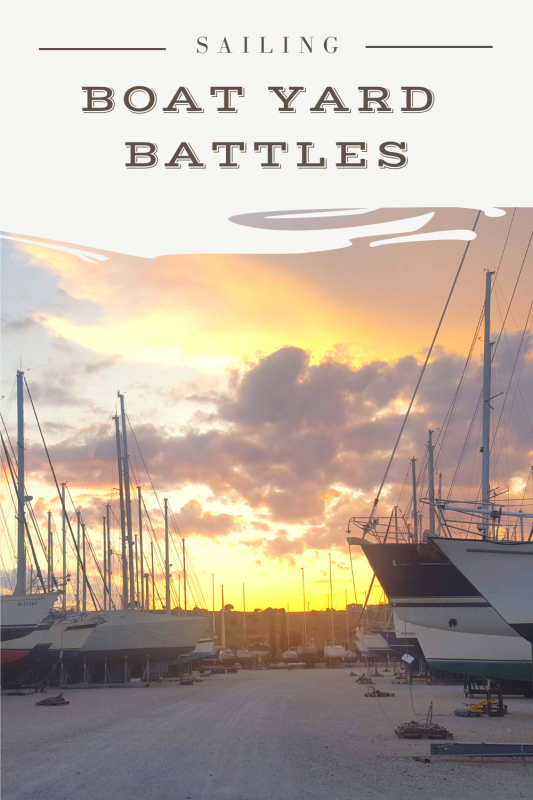
Boat Yard Battles
- Search Search Hi! We’re Emily, Adam and Tiny Cat, liveaboard sailors travelling the world on our 38ft sailboat and writing about it as we go. We hope we can inspire you to live the life you’ve always dreamed, whether that’s exploring the world or living a more simple way of life in a tiny home. Find out more. Patreon
- Privacy Policy
- Classifieds
- Remember Me Forgot Password?
- Boats Sailboats Build Log How to make sailboat rudders and keels in 6999 easy steps
- Electric Flight
- Advertising
- Our Sponsors
- Review Policies
- Terms of Service
- Privacy Policy
- Site History
- Mark Forums Read
- Member Search
- Upcoming Articles
- Do Not Sell My Data
- Manage Consent
- Back to Top
13 Popular Full Keel Sailboats Worth Considering
Full keel sailboats are very stable and durable - they are great for cruising long distances. But there are disadvantages too. Let's look at what models to consider, and why.
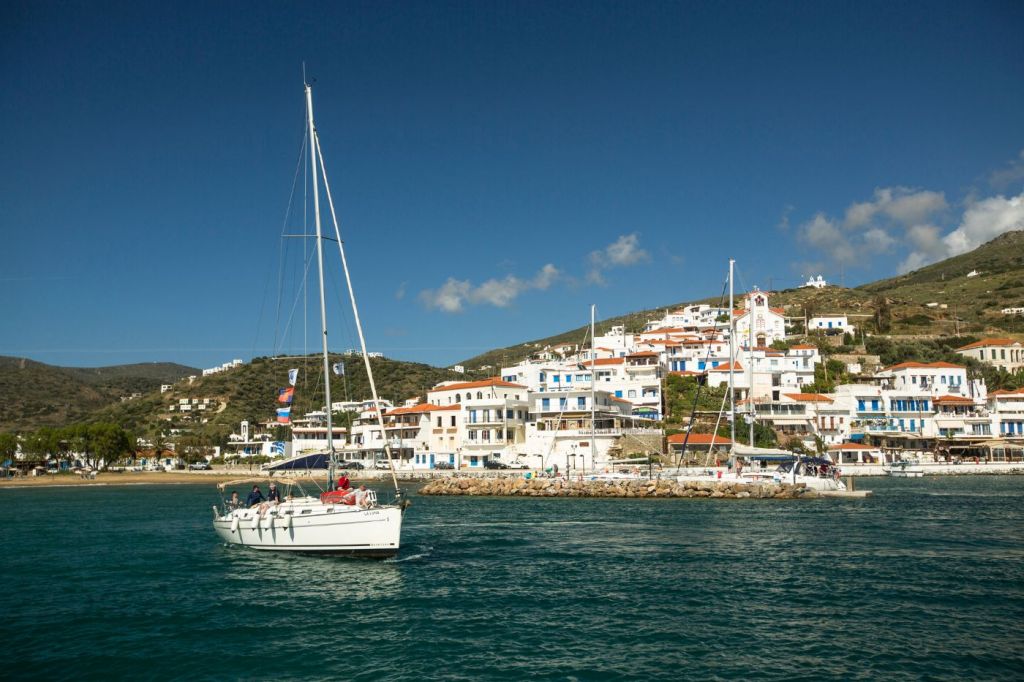
Here are 13 good full keel sailboats that are worth considering:
Nicholson 32
Island packet 380, folkboat 25, cape dory 36, vancouver 32, tradewind 33, endurance 50, westsail 32, hans christian 52.
First of all let's have a look at why you should even be preferring full keel sailboats to a more traditional, widespread classical fin keel design.
Full Keel Advantages
As with everything, there are plenty of pros and cons on each side. Full keels generally provide better handling if the weather gets tricky, they track better, provide more stability downwind, and generally stabilize the boat movements better.
Furthermore, they are way more robust, thus less prone to damage. Running ashore isn't as big of a deal as it is with a fin keel and your rudder and propeller will be more protected with the mass of the keel in front of them.
Full Keel Disadvantages
With more mass and drag comes less speed. Plus the large surface area underwater holding the direction will result in a wider turning radius, which might be annoying in smaller spaces.
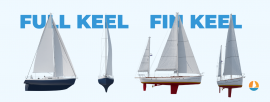
Fin Keel vs Full Keel: Pros and Cons & When to Choose Which
Fin keel advantages.
The largest advantage of fin keels is their speed. They also provide better maneuvering and a better turning radius.
Fin Keel Disadvantages
It is inevitably more prone to damage though, wear and tear will be a way bigger issue than a full keel. They won't have your back when a gust comes since the water-resistance to the side will be smaller.
It seems then that for serious longer passages, liveaboards, and long-term sailing, full keels are better. As long as you don't care for speed as much, but are concerned about the boat having your back, this is the answer. So let's now look at the superstars of the full keel universe.
The very prototype of a long-distance tough cruiser. It has been with us since 1963 and happens to be among the first fiberglass boat models produced on a mass scale. Nicholson 32 went out of production in 1981 and it was a model approved for the 2018 Golden Globe Race, proving that even older Nicholsons are still standing strong due to their toughness and ease of repair.
They were supposedly as durable as if made out of steel. Though I'll leave up to you whether you want to see that as a marketing claim or reality, such a statement can not be made without some base.
Plus the newer models have a lot of interior space, are manageable for solo sailing, and provide a sturdy ride to take one around the world.
The story here is similar to the above Nicholson - meaning that we are looking at one long-lasting high-quality cruiser. Not just because of this specific model's build - Island Packet in general was always known for this. And it is among the very few companies that, in the modern era, keep making full keel boats.
In other words, you don't see many shipyards focusing on full keels these days, so if you want one and you would rather go with a new boat, Island Packet will be one of the stops you will very probably make when doing your research.
If you are looking for reliable cruisers, you will like this one, since cruising is what it was built for, even if it meant sacrificing some performance aspects. It has a wide beam, a lot of interior space, all of the amenities a comfy cruiser should have, such as a big refrigerator with a freezer, as well as a fully equipped kitchen. The long keel here serves as a comfort helper, since, as mentioned before, it adds to the stability and reduces motion.
Not to sound repetitive, but the word 'reliability' has to be mentioned again. It seems that boat builders who choose the full keel design have something in common.
But since this particular boat was born during the Second World War and has been going strong to this very day, what other words to describe it? It has the Nordic blood in its veins since it was thought into existence by the Scandinavian Yacht Racing Union and since it prefers just about everything over comfort.
The boat is very stable, not just because of its full keel, but also because of its insane 55% ballast ratio. For those who haven't come across this before, the ballast ratio is the ratio of the ballast weight relative to the boat weight. So for instance the nearly 9 tonne Bavaria 40 with its almost 3 tonne ballast has a ballast ratio around 30 percent.
Thus you can imagine that a boat that 'wastes' more than half of its weight on ballast is serious about rigidity. These are performance racer numbers. But of course, if you are designing a boat that has to withstand the Scandinavian storms, you don't have a choice than to go overboard with specs. So if this toughness is what you seek, look no further.
...although as far as I know, all Cape Dory boats have full keels, regardless of their length. Their 36-foot model is just their most popular one. Cape Dories are known for their sturdiness, ability to cross the oceans because of their stability, and relative ease of handling.
They were engineered by Carl Alberg, who was inspired by the Scandinavian Folkboat, where reliability is worth more than comfort, or the interior space. This boat rocks a heavy rig for hardcore traveling, but its 1.5-meter draft makes it ideal for coastal cruising as well.
What's quite interesting about this particular model is that during its lifespan it went through very few changes. Boats usually evolve, sailors' feedback is taken into consideration for upgrades, but Cape Dory 36 remained relatively unchanged inside or out. This is a big compliment, since the brand started out in 1963, stopped production in 1991, and sold its blueprints so that they could be built further. Talk about longevity.
Let's progress in technology! Just because a long keel is an old-fashioned or more traditional approach, it doesn't mean it remains monolithic in its ideology. There were innovations in the concept, such as cutaways in the keel, to reduce the biggest drawback of this design, the drag.
So it only makes sense that Vancouver, a company that had distinctiveness and innovation in its mission and vision, would take part in this. Their 32-foot model that begun its lifespan in the early eighties, had a deeply cutaway forefoot, plus a rudder that was wider the deeper it was underwater, meaning its widest point was at its lowest point. This was to increase efficiency, and rudder response.
Technicalities aside, this boat was very well made, no corners cut, no expenses spared. This resulted in quite pricey vessels, out of reach of many, but much time has passed since, so today it can be yours for around 40 000 USD and up. And since the build quality was so high back then, you can still enjoy a proper boat, usually at a higher quality than boats equal its age.
The great thing about Australian sailboat makers is that they design their boats for long passages. How else would they get off of the continent? Freya 39 is a good example of this since it has not only circled the globe many times but also won the Sydney-Hobart Yacht Race three times consecutively. And that's a famously hard race.
The boat is built like a tank, with thicker fiberglass walls than you would find in its rivals. Despite that, its owners claim to have crossed over two hundred miles per day on it, a figure that is well known when it comes to this model. Which sounds plausible with its 7.8 kts of hull speed.
Its construction makes her one stable boat since it has been noted that during races, it was able to carry a spinnaker longer than its competitors, well into the 30 knots of wind speed.
The only drawback here is that if you fancy it, since it is so highly valued, and in demand, it will be tricky to find one to buy. And once you do, prepare to pay around 60 000 - 90 000 USD for it.
This one comes with a story attached to it. Once upon a time, a naval engineer Nick attempted to sail around the world. Halfway through, his boat gave up, which meant a lot of trouble for Nick, but he exited this disaster with a pretty precise idea for what his next project would be. He set on to design a boat that would be so sturdy that his sailing misfortune would never repeat.
Out of this incident paired with a smart brain, Wylo 2 was born. To make sure his design stands, after putting this boat on the water, he proceeded to live on it, while circling the globe a few times.
Others, seeing this success, bought his designs and they became quite widespread. As you might have guessed, this boat has a lot of space for living, for storing equipment and provisions, so it is comfy to live on, not only for your body but because of its sturdiness, for your mind too. These designs have accomplished some astonishing feats in all corners of the world, so if you put your trust in this design, you won't be making a mistake.
If I said this boat is sturdy and ready for just about any destination, I'd really be repeating myself now. So while that's true, let's talk about what's special about Tradewinds 33.
It has a rather small cockpit, so on-deck dinners while watching the sunset with the whole crew might be a bit improvised, but the space saved is used for an impressively spacious interior as well as a nearly flat deck. So moving about is a pleasure.
For liveaboards, this is a good idea, since storage space will be plentiful. Plus it's an elegant looking boat, with a forestaysail as a default setup. So rock on.
Time for a larger boat. So that if you want something that won't lack anything you might wish for, including space, I have something for you too. All Endurances are full keels, so if you fancy a smaller model, there is a way.
Even though it is relatively new, (you will find models from around 1995) it will make you feel like a medieval pirate, with its old-school helm, wooden interior, and a spacious aft cabin that has large windows facing back!
It is a proper bluewater cruiser, built in South Africa based on a famous Peter Ibold's Endurance blueprint. It sleeps a whole family, so if a circumnavigation with a few friends is what you seek, this is one for you.
If you are up for some single-handed sailing, pause here for a bit. Small sailboats are usually nimble, on the top of it, this one is also quite sturdy and stable, as full keels are.
You won't find much space below the deck, so don't expect to have a party of more than around two people, but at least it's a good looking interior, with charming round windows and many of the usual amenities.
They say that Mason sailboats are premium quality for a non-premium price. I wonder whether them being built in Taiwan has something to do with it.
Here is a quote by an owner of a 1986 model that says it all: "I am absolutely captivated by the boat and am not objective at all in my feelings toward her. The general construction is of the highest standard. Like an Irish hunter, she is a workhorse and a lady-maybe not quite as fast around six furlongs as a racehorse, but for the long pull, through timber, brush, and over walls, she is really something."
Now although this owner admits subjectivity, this boat indeed was built with quality in mind. Sturdiness too - not only is its fiberglass hull properly solid, but it also features longitudinal stringers to add further rigidity.
There is a lot of brightwork, which might sound nice at first glance, but since it requires quite a lot of maintenance, some owners even said they could do with less wood if it meant less upkeep.
All in all though, when it comes to getting a lot of boat for not a lot of money, this is it.
Does it make sense to even praise how heavy and sturdy this boat is built? Probably not at this point. Just know it ticks all the boxes. It is made of 12 layered fiberglass for Pete's sake.
The design was based on ideas of the Norwegian engineer Colin Archer, who made his boats such that they could withstand the northern seas. Pair that with the fact that the interior here is surprisingly spacious with 6 ft 2 in of headroom and you've got yourself one comfortable circumnavigator.
The issue stemming from the heavy build and a full keel, which is a slower pace, applies here more than usual though. This boat is absolutely reliable, but don't expect winning speed races.
Sadly, Westsail 32 was in production only for some 9 years. Sales were booming, they made over 800 boats, but bad business practices and cash flow issues resulted in its demise.
Not the author, the boat. If beauty and elegance are what you are after, this one will catch your eye. Just as was the case with Mason, these boats were produced in Taiwan. But since the goal of the engineers was to create the 'ultimate cruising sailboat' and they spared no expense, expect to pay hundreds of thousands of dollars for these boats, even though decades old.
The gorgeous classical design paired with the high build quality makes these exclusive pieces of work, plus quite a modern one since they ceased production in the 90s. So if you don't mind the higher price mark and are looking for something relatively new, that will, thanks to the build quality, last you for many years to come, this might be your choice.
Full keel sailboats are sturdy. Not only is that because of the full keel which itself provides a lot of structural integrity. But also because the choice of putting the full keel in means you are building something that prefers ruggedness and reliability over anything else. So it is logical that the rest of the boat will be built in the same fashion.
So if you don't mind sacrificing the few knots of extra speed, if you don't mind the smaller pool to choose from, if you want a boat that will have your back in pretty much any situation and place you will choose to go to, if you want to sail the Scandinavian design, go for it.
Arthur Rushlow
What a great page. Both my wife and I sailed Faulk Boats out of Canada prior to our moving to Florida. Once we arrived in Florida we had a Soveral 26 built we raced for three years prior to my returning to College and now 5 degrees later I am an Anglican Bishop with no boat.
Leave a comment
You may also like, 5 surprising advantages of a full keel sailboat.
Modern keel designs favor fin keels, with the high-performance boats using bulbs with narrow chord sections and deep drafts. Very few full keel designs are being …

Fin Keel vs Full Keel: Pros and Cons & When to Choose Which
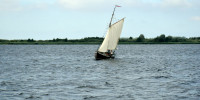
7 Legendary Solo Bluewater Sailboats Worth Considering
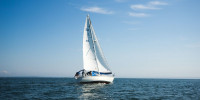
13 World-Famous Bluewater Sailboats Under 40 Feet

17 Legendary Bluewater Sailboats Under 50 Feet (with Photos)
Own your first boat within a year on any budget.
A sailboat doesn't have to be expensive if you know what you're doing. If you want to learn how to make your sailing dream reality within a year, leave your email and I'll send you free updates . I don't like spam - I will only send helpful content.
Ready to Own Your First Boat?
Just tell us the best email address to send your tips to:
- BOAT OF THE YEAR
- Newsletters
- Sailboat Reviews
- Boating Safety
- Sailing Totem
- Charter Resources
- Destinations
- Galley Recipes
- Living Aboard
- Sails and Rigging
- Maintenance
- Best Marine Electronics & Technology

Sailboat Review: Tartan 455
- By Herb McCormick
- March 12, 2024
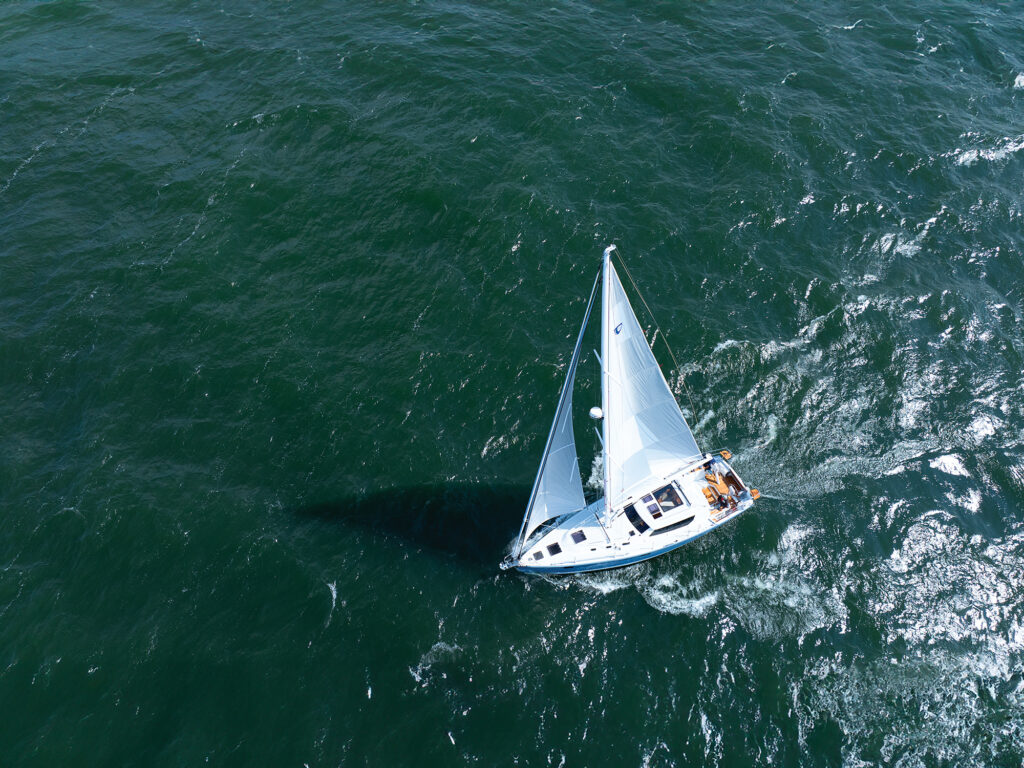
For me, for many reasons, certain boats and brands are synonymous with the waters or regions where they were created. The places are an essential component of the boats’ DNA. I’ll always associate a varnished mahogany runabout with upstate New York, or a cool little vintage catboat with Buzzards Bay and southern New England. Every classic Hinckley or Morris that I come across paints a vivid portrait of coastal Maine. Even yachts that sail or cruise far and wide all over the world still convey a sense of place. Recently, aboard a new Tartan 455, we pointed the bow into choppy Lake Erie, and I intuited an instant connection to the nearby northeast Ohio plant where the boat was spawned. It all felt like home.
Other people see different things. After I uploaded a photo to social media of myself steering the 455, an old pal quickly hit me back with a comment, asking: “Tartan is still building boats?”
The answer is an emphatic yes, and pretty darn good ones at that. The company has certainly had its ups and downs over the years, but it’s now navigating smoother waters for a couple of major reasons. First, it was recently acquired by Seattle Yachts, which made significant investments in the product and facilities, and appears firmly committed for the long haul. Second, longtime Tartan designer Tim Jackett is running operations, and the native Ohio homeboy is giving it his all.
Jackett says that the 455 evolved from powerboats by Legacy, a company Tartan acquired in 2010. “The roots of it came after having some exposure to the Legacy brand and looking at how the deck and interior of that sedan style of powerboat works out so nicely,” he says. His first swing at the design in sailboat mode was a 37-foot motorsailer with a substantial trim tab that powered up at 14 knots. (It was never built.) When the owner of a Tartan 3700 approached him about commissioning a larger boat, Jackett returned to expand upon his earlier incarnation.
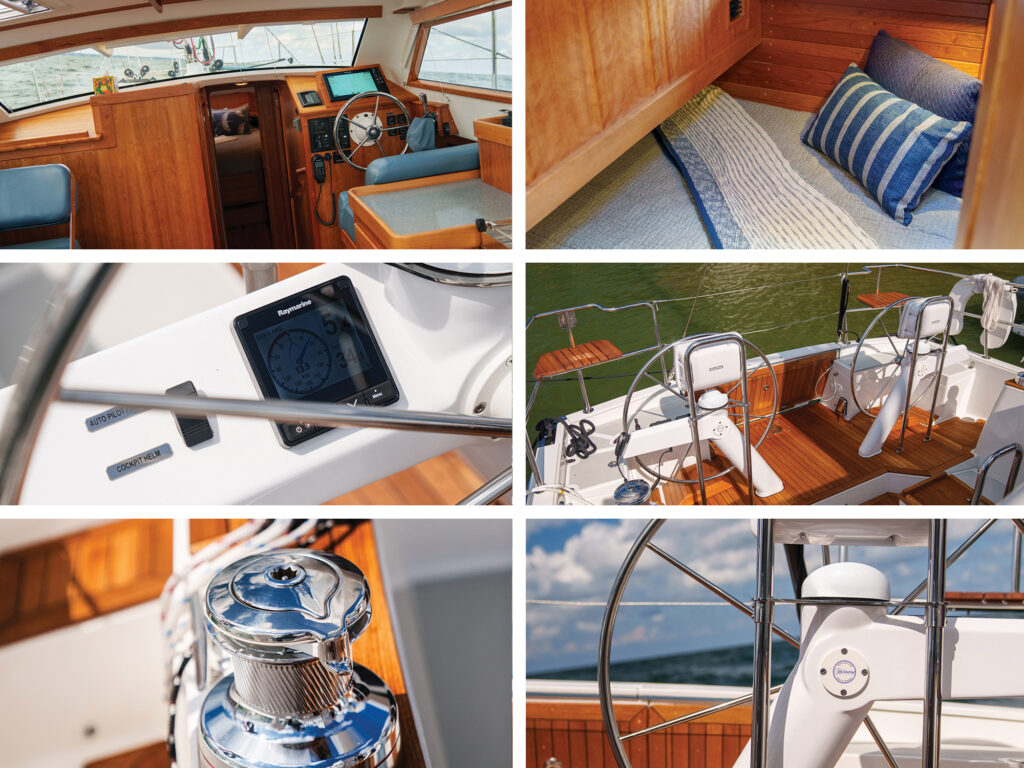
“But the concept was the same,” he says. “More of a sailing hull, but a nice, big, well-lit living space with inside steering, and then an aft cockpit that gave you the normal sailing experience of wind and water in your face when you wanted it.”
Jackett says that the 455 evolved from powerboats by legacy, a company tartan acquired in 2010. His first swing at the design was a 37-foot motorsailer.
Down a few steps into the deep cockpit, sliding doors open into the salon, which transitions into the forward living areas. The bulletproof laminate is a vacuum-bagged, infused sandwich that employs epoxy resin with a foam core in the hull construction and end-grain balsa in the deck. The lead keel supports a hefty ballast bulb and is available in deep- and shallow-draft configurations.
There are a couple of accommodations plans, including a two-stateroom version or the three-stateroom layout employed in the model we sailed, with guest staterooms to port and starboard, and an owner’s space forward with an attached head. The well-executed joiner work and furniture were cherry, though teak and maple are available (much of it sourced from northeast Ohio’s Amish mills). I’d say that this is primarily a comfortable couple’s boat with space for occasional visits from family and friends.
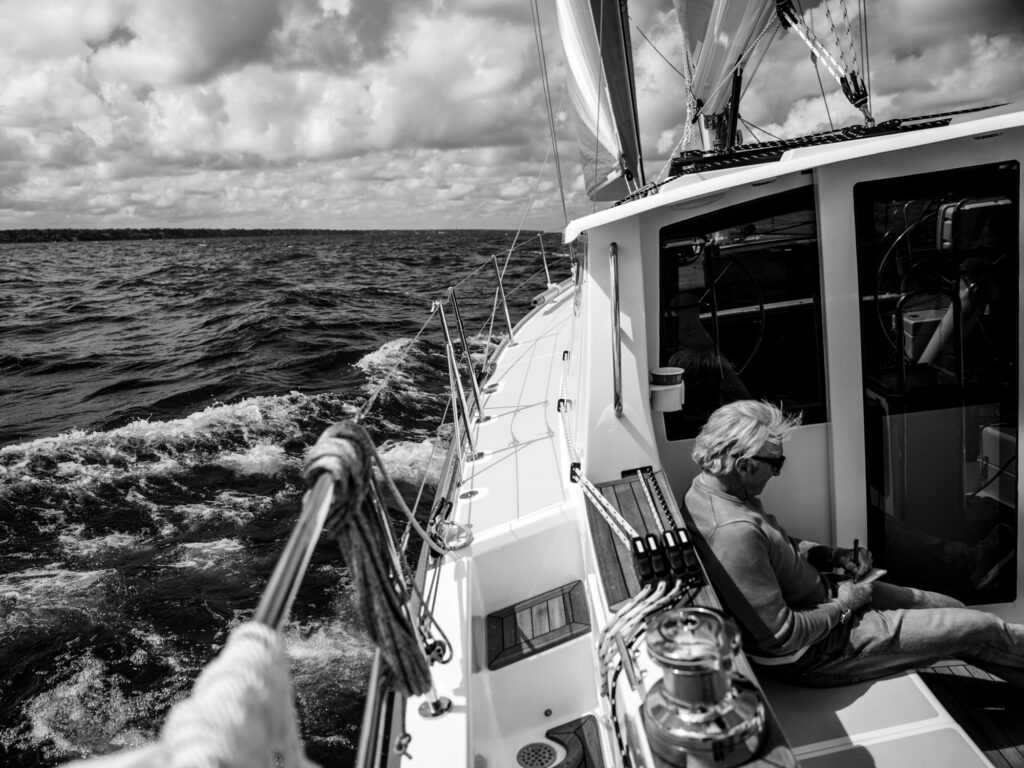
Aesthetically, I found the lines plan of the 455 to be handsome and pleasing—not a particularly easy task with a large deckhouse, which Jackett incorporated nicely into the profile.
This is primarily a comfortable couple’s boat with space for occasional visits from family and friends—A big boat but an easy one to negotiate.
Wraparound windows allow light to pour in from all directions, as does the deckhouse’s overhead window. A split hydraulic backstay provides easy access to the drop-down transom and boarding platform between the twin wheels, which are stationed well outboard. (There’s a single, deep spade rudder.) Moving forward, an outboard ramp rises from the cockpit to the side decks, which makes for easy egress to the topside and foredeck. I believe that this feature originated with the Jeanneau line, and I always thought it was a trend that would spill over to other builders (see the Moody 41DS). It’s just too simple and elegant a solution to an age-old design conundrum. There are grippy stainless-steel handrails just about everywhere. This Tartan is a big boat but an easy one to negotiate.
The carbon-fiber double-spreader rig is fashioned in Tartan’s in-house autoclave, as are the rudder post and other reinforcements. The company’s Cruise Control Rig double-headsail sail plan (also known as a Solent setup) has become a fixture across the brand, with a code-zero-style reacher on the forward stay and a smaller, self-tacking jib on the aft one. The powerful, full-battened mainsail is stashed in a Leisure Furl in-boom furler, and there’s a wide traveler atop the deckhouse that facilitates the end-boom mainsail sheeting. All the running rigging is led into the cockpit and handled by a combination of rope clutches and Harken electric winches. The excellent sails come from Sobstad’s loft in nearby Rocky Hill.
Over the years, I’ve sailed many a Jackett design, and the common denominator is they sail exceedingly well. We sailed the 455 on an early-fall afternoon after a cold front rolled through, offering up ideal 10- to 15-knot northwest breezes. The waves in the relatively shallow lake were closely spaced. As I took the wheel and came onto the wind under the smaller jib, it took me a while to stop pinching and get in the groove. But once I fell off a good 10 degrees, the boat and I settled in, and it muscled through the chop with aplomb.
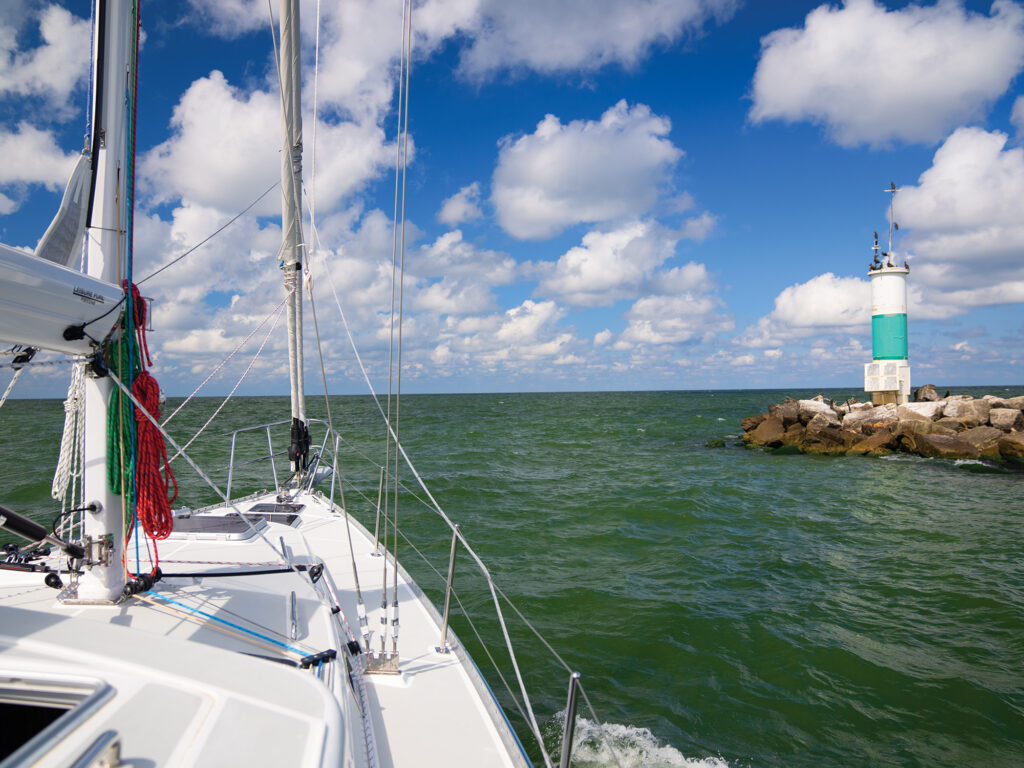
The steering was tight and accurate. Jackett says that he was still playing with the optimal rudder configuration, but it all felt fine to me. Topside, the Jefa wheels are cable-controlled, while the deckhouse steering station is on a hydraulic ram. You toggle between the two, depending on where you’re driving. We swapped out the self-tacker for the large reacher and bore off another 10 degrees, and the boat absolutely lit up, trucking along on a beam reach at bursts over 9 knots in complete and utter control. We even jibed the big sail through the exceedingly tight foretriangle, a maneuver I wouldn’t have thought possible. It was quite the sail.
Fittingly, the first Tartan 455 is going to live on the Great Lakes, with Lake Huron’s North Channel a likely regular cruising ground. But I can envision this being a terrific yacht for the Pacific Northwest and beyond, and ideal for high-latitude adventures. You might not be able to take the Ohio out of a Tartan, but you can take this Tartan just about anywhere.
Where It All Began: Tartan 27
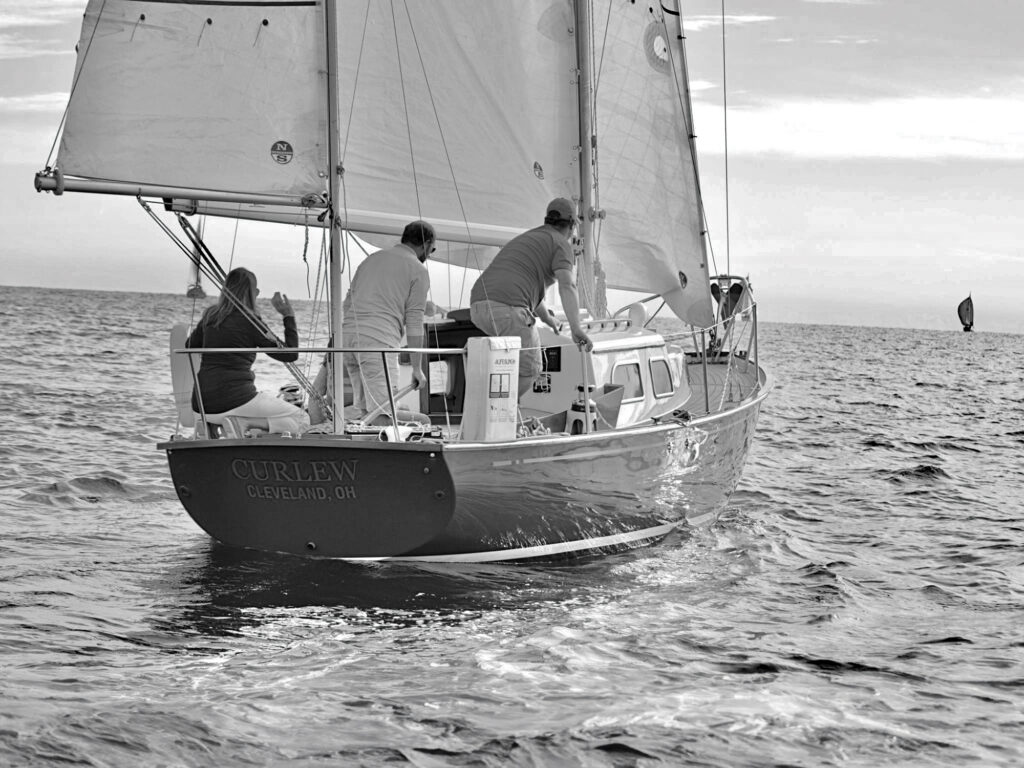
On the back lot of Tartan’s headquarters in Painesville, Ohio, the exact boat that started it all—Hull No. 1 of the sweet little Tartan 27 line, of which more than 700 were eventually built in a production run that lasted until 1979—is awaiting a complete refit. It was fun and enlightening, after sailing and reviewing Tartan’s latest offering, to consider how production-boat building and design has evolved during the past 60-plus years. The changes have been extensive.
The Tartan 27 was a collaborative effort between Douglass & McLeod Inc., an Ohio-based builder of one-design wooden dinghies such as the Thistle and the Flying Scot, and Charlie Britton, a sailor and businessman who was also reared on the shores of Lake Erie. Following his service in the US Navy, Britton sailed his 42-foot yawl from Japan to the West Indies, a rather unheard-of voyage in the late 1950s. Once home, he joined forces with D&M to commission a 27-footer for coastal cruising and club racing. Being Scotsmen, they decided to name it Tartan.

There were a lot of firsts involved here: The T27 was D&M’s first fiberglass boat, and it was one of the initial glass designs from the venerable East Coast firm of Sparkman & Stephens. The chief designer for the project was a young naval architect named Bill Shaw, who would go on to become the principal design chief at Pearson Yachts, where he designed dozens of models.
Hull No. 1 launched in 1961. With its boxy coachroof and low-aspect masthead rig, it’s hard to believe today that the T27 was considered a performance racer/cruiser at the time, but as such, it was an immediate success. It was designed to compete under the popular Cruising Club of America rating rule of the early 1960s. Like other yachts of that period, including the Pearson Triton and Hinckley Bermuda 40, it featured long overhangs and a short waterline, a narrow beam (8 feet, 9 inches), moderate displacement, a long keel, shallow draft, an aperture-mounted propeller for the Atomic 4 gas engine, a keel-hung rudder, and slack bilges. Most of the early T27s were sloops, though it was also offered as a yawl, which did well under the CCA rule.
At 7,400 pounds displacement, it was not a light boat, but when slightly cracked off, it tracked to weather like a demon. Unlike the Triton, which had a fixed keel, the T27 was a keel-centerboard boat that drew 6 feet, 4 inches when the board was lowered, and a mere 3 feet, 2 inches when raised, making it highly versatile as a pocket cruiser. The original centerboards were bronze, which must have raised some mighty maintenance issues, and is likely why it was soon switched over to steel encased in fiberglass. The ¾-inch fiberglass hull was a proverbial brick house; the deck was balsa-cored. At the time, the construction was state of the art.
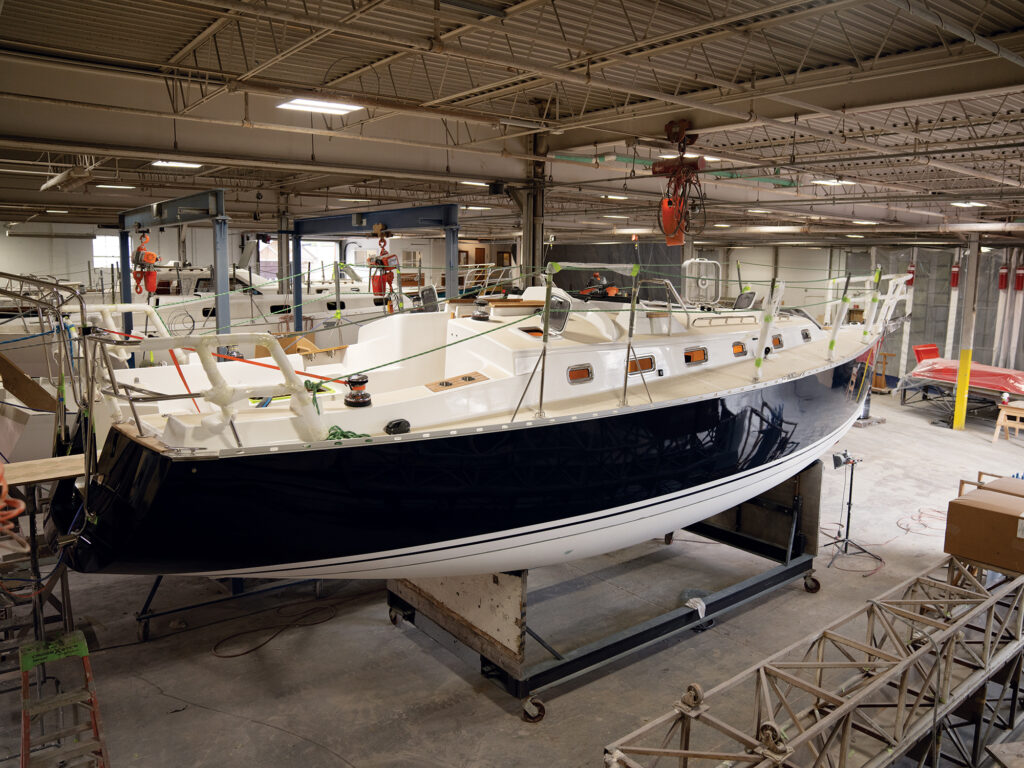
D&M followed up the T27 with a couple more venerable “classic plastic” legends, including the Ted Hood-designed Black Watch 37 (which eventually was remodeled and relaunched as the Tartan 37) and another S&S benchmark, the Tartan 34, an expanded version of the T27 that also had a centerboard. Man, for many years, I was bewitched by the 34-footer, and you can still find all of these models in harbors everywhere.
After a fire in 1971, D&M sold Britton the Tartan division, starting a whole new chapter in the company’s storied history.
As I steered the latest Tartan—a systems-rich yacht finished to an incredibly high degree—I could only wish that Britton were still around to experience the power and speed of a contemporary, long-range cruising yacht. I have no doubt that he’d be amazed, but that sweet little Tartan 27 of his was the inspiration for all that followed.
- More: Print March 2024 , Sailboat Reviews , Sailboats , tartan yachts
- More Sailboats

Meet the Bali 5.8

Celebrating a Classic

New to the Fleet: Italia Yachts 12.98
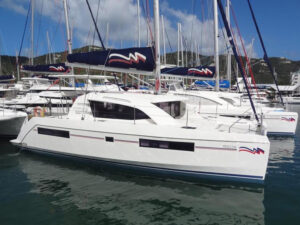
Leopard 40 Prelude Listed For Sale
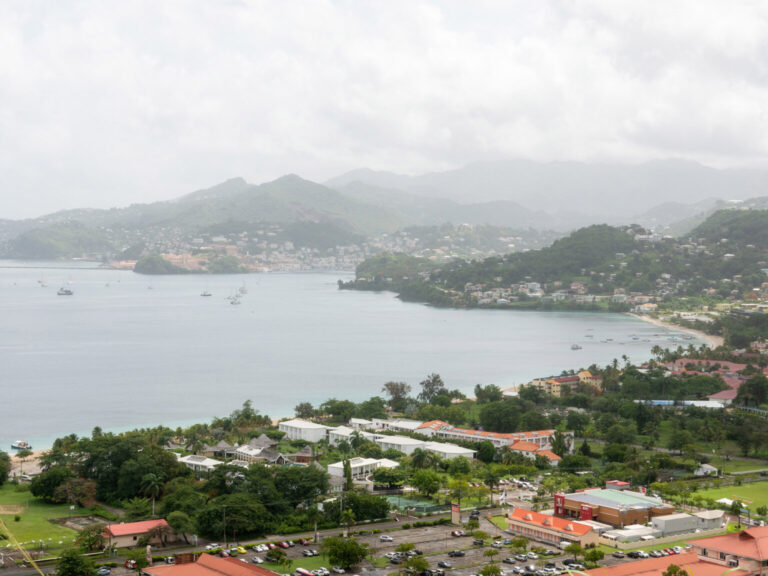
Grenadines Boat Hijacking Suspects Charged with Murder
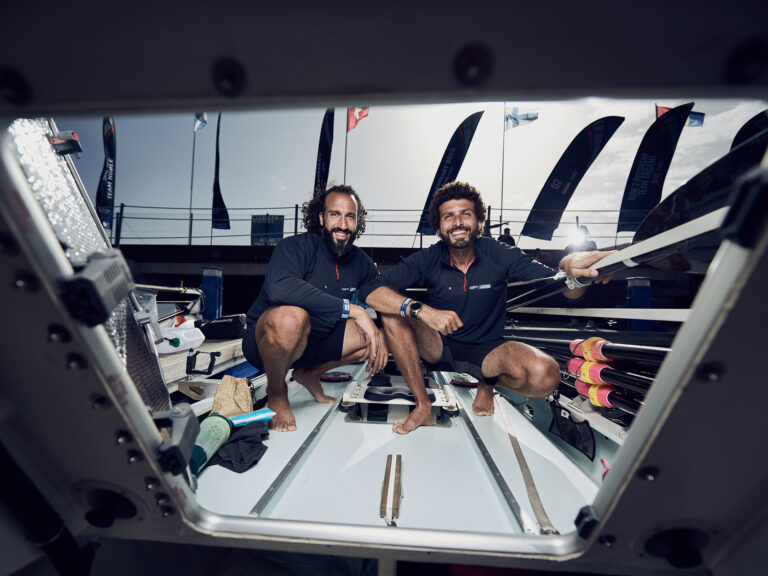
13 Hours in a Life Raft
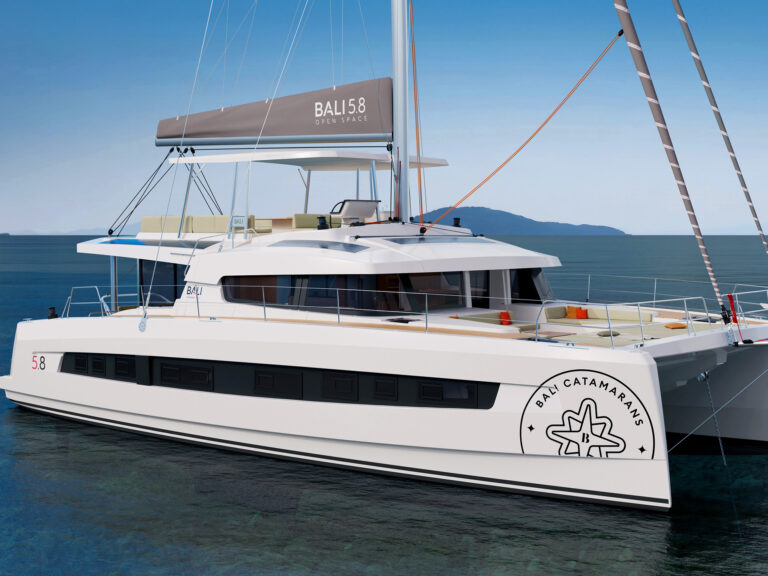
- Digital Edition
- Customer Service
- Privacy Policy
- Terms of Use
- Email Newsletters
- Cruising World
- Florida Travel + Life
- Sailing World
- Salt Water Sportsman
- Sport Fishing
- Wakeboarding
Many products featured on this site were editorially chosen. Cruising World may receive financial compensation for products purchased through this site.
Copyright © 2024 Cruising World. A Bonnier LLC Company . All rights reserved. Reproduction in whole or in part without permission is prohibited.

IMAGES
VIDEO
COMMENTS
Full keel rudders. Many sailboats have a full keel rather than a fin keel, which requires a particular type of rudder. A full keel is the standard type of keel, or flat blade at the bottom of a sailboat. A full keel is designed for stability, not speed - it can keep you safe in rough water.
The most common sailboat keel types are full-length keels, fin keels, bulb keels, wing keels, bilge keels, and lifting keels. Full keels are popular among cruisers, while fin keels are generally used for racing. ... The keel encompasses the rudder, preventing any rogue ropes, weeds, or rocks from damaging the rudder. Example of a fin keel with ...
sailboats. These variations include the "elliptical" keel with shortened root chord and exaggerated midchord lengths. The goal of that design was to reduce the hull-to-keel root chord interference drag. As I'll suggest below, though, there's a better way to minimize drag at the junction of the hull and keel root. The surface of the hull provides a
Keel-mounted rudders are attached to the boat's keel, which is the central structural element that runs along the bottom of the hull. Spade rudders are free-standing rudders that are not attached to any part of the boat and are commonly used in racing sailboats. The type of rudder used depends on the boat's size, design, and intended use.
Full Keel Rudder Sailboat. The classic, robust offshore sailboat is designed with a full keel that runs from stem to stern. With this sort of underwater profile, it only makes sense that the rudder would be attached to the trailing edge of that enormous keel. On inboard-powered sailboats, the propeller is usually mounted inside an opening ...
If the boat has an efficient keel and the leeway angle is only a few degrees, the rudder can beneficially operate at a 4-6 degree angle. The total angle of attack for the rudder will be less than 10 degrees, drag will be low, and pointing will benefit from the added lift.
Sailboat Rudders. The primary purpose of sailboat rudders is of course to give the helmsman the ability to steer the boat, but a well-designed one will also provide hydrodynamic lift to windward, in the same manner as does the keel. These twin high-aspect ratio rudders on an all-out race boat are clearly optimised for their hydrodynamic ...
How keel type affects performance. James Jermain has tested hundreds of yachts in his 30 years as Yachting Monthly's chief boat tester. The performance and handling of a yacht depends on many things, but perhaps the most important single feature is the shape of the hull and the profile of the keel. Over the years hulls have become shallower ...
Sailboat keels usually carry iron or lead ballast in their tip to act as a counterweight to the wind's force on the sails, which reduces heeling. The keel's length acts as a lever, increasing the ballast's effectiveness and improving its stabilizing properties. In other words, the deeper the keel runs and the heavier its ballast is, the more ...
Sailboat rudders are simple devices. Rudders are essentially deflectors, as they deflect water to port or starboard as the boat moves along. When the rudder is amidships or in the middle and aligned with the keel, the boat goes straight. Rudders also help keep the boat on a straight track as they increase the area of water moving down the ...
Attaching the rudder to the keel makes it far less prone to damage from flotsam and fishing pot lines, but the helm feels heavier as a result. Long keels also give a boat great directional stability, which makes them ideal for windvane self-steering, which contributes to their enduring popularity with long-range ocean cruising sailors.
Sailboats utilize a long keel, skeg, or blade to keep a straight course under sail. The keel is one of the most important parts of the sailboat structure, and it's often the first major piece to be laid down during construction. The keel is the backbone of the boat and often contains a significant amount of ballast to keep the boat stable.
Some fin keel sailboats have a skeg-mounted rudder like the one shown. The skeg offers the same advantages as a keel mounted rudder: the rudder is protected from objects in the water and has more structural strength than a rudder mounted only on the rudder post. It also has the same disadvantage: because it is not "balanced" as a spade ...
All types explained. The keel type is one of the most important features of your boat. But the different designs can be confusing, so I've set out to create a very clear guide that will help you understand sailboat keels once and for all. After reading this guide, you'll know which keel types are available, and what their strengths and ...
Skeg rudders might give a full keel rudder a run for its money due to its durability. These are often referred to as skeg mounted rudders. These are similar to full keel rudders, but can also be used on fin keel boats. This alone gives it a slight edge over full keel rudders, but each boat design will differ. Advantages of a Skeg Rudder
A basic sailboat is composed of at least 12 parts: the hull, the keel, the rudder, the mast, the mainsail, the boom, the kicking strap (boom vang), the topping lift, the jib, the spinnaker, the genoa, the backstay, and the forestay. Read all the way through for the definition of each sailboat part and to know how they work.
Re: Sailboat rudder design. A couple of more benefits of a keel-hung rudder with an angled post is that: 1: It allows for more rudder in the deeper, denser water which is great when you're in a seaway and the stern is lifting over crests, as it lets the rudder maintain bite in the water.
A full keel runs from end to end of the boat lengthways. A full keel, as the name implies, runs almost the entire length of the boat. At a minimum, it must run 50% of the length of the boat. A full keel is one of the most stable keel types, which is why it is so common. Full keels are also safer should you run aground.
The sail with keel and rudder is an essential sailing trio. A keel is the bottom-most, sturdy structural "ridge" around which the hull of a boat (and ship) is built. It's like a partially external backbone that runs along the centreline of the boat, from the bow to the stern. This ridge defines the longitudinal profile of the hull - it ...
Rudder on a Full-keel sailboat. Full-keel boats or modified full keel boats usually have this type of Rudder. These rudders are typically hinged to the aft edge of the keel to make a continuous surface, not to create any drag after the main keel. Engine propeller is usually positioned between the keel and the Rudder.
A sailboat keel is the fin that hangs underneath a sailboat like a dagger, providing stability against strong sideways forces of wind. The design is crucial to hold the boat upright and make sailing tack easier, with its depth and shape involving meticulous calculations of size, weight, center of gravity, providing buoyancy, and other features.
The simplest solution is to offset the trailing edge in our software a few millimeters. The mold will then have a smooth taper at the trailing edge that is easy to finish off. Once the part is popped out, the sharp trailing edge can be cut back with a hobby knife, leaving a thin, but durable edge.
Here are 13 good full keel sailboats that are worth considering: Nicholson 32. Island Packet 380. Folkboat 25. Cape Dory 36. Vancouver 32. Freya 39. Wylo 2. Tradewind 33.
Like other yachts of that period, including the Pearson Triton and Hinckley Bermuda 40, it featured long overhangs and a short waterline, a narrow beam (8 feet, 9 inches), moderate displacement, a long keel, shallow draft, an aperture-mounted propeller for the Atomic 4 gas engine, a keel-hung rudder, and slack bilges.